
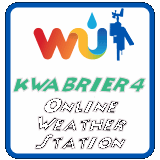
|
This site is a more complete version of my original radio page, which was HERE |
Welcome to my virtual shack! I am a ham radio operator holding Extra-class callsign K7WV. Having been an avid shortwave listener and MW DXer for the prior 23 years, I finally took the plunge into ham radio in 1994 after leaving the Air Force. With the difficulty involved in operating from condos & apartments, I have had to wait until the purchase of my present QTH to become active. As of 1999 I am QRV, making contacts and collecting cards from here in the greater Seattle area (Brier, Washington grid CN87ut). Here are my previous briefly held licenses and callsigns:
| KE4MQZ (General) June 1994 |
| KS4BK (Advanced) September 1994 |
| AD4YR (Extra) November 01 1994 |
| K7WV (Extra, vanity call) November 27 1996 |
I never was a
Novice or Tech, but a General
from day one, having been a walk-in, sitting for and passing three
writtens
and the 13wpm code. I then advanced a class at each
subsequent testing
session at the CFARS
club (administered
every two months) in North Carolina until I had my Extra two testing
sessions (four months)
later.
Despite this I never made an HF contact using my ex-calls.
I obtained my present "1x2"callsign through the FCC's
"Vanity Callsign
Program" (Gate 1). My Amateur Extra class license is the
highest of
the amateur license classes and allows me full priveleges on all bands
authorized
to the radio amateur. The new restructuring rules make it
vastly easier
to obtain this class of license. I had to pass a 20 wpm morse
test;
today the morse requirement is no more, devaluing the specialness of
the
Extra license somewhat (at the time only 5% of hams were Extra) but
still
the one to get for full privileges.
I went QRV on Aug 15 1999 on the 40 - 10 & 6 meter bands. (Also have 2M FM). The antenna for 40 thru 12 is still a "DXEE" 40-foot-long "shortened" dipole with resonator coils, mounted above the rooftop as an inverted V. Not a great performer but I did just manage to work KC4AAA at the South Pole with it on 20M. [Nov 19 2000] Installed homebrew 2-element monoband yagi for 10 meters. [Mar 11 2001] 100th DXCC country worked on 10M. [Sep 10 2001] QRV on PSK31, RTTY and SSTV modes.
On the "Magic Band" (6M) I'm using a 3-element yagi up 30 feet (9 meters), running 100 watts. In May 2000 I went QRV and started working toward VUCC. The 6-meter VUCC award requires 100 grid squares confirmed by QSL. My grid count is currently 214 worked, 158 confirmed.and I hold 50 Mhz VUCC #1105, the first to be awarded in the new millennium. I'm now chasing 6M WAS. I only need 1 more state (KY) and would certainly have worked it already with a 5-element antenna (future upgrade?) UPDATE: The 3-element antenna was destroyed by a falling tree along with the rest of the yagis, and I had a "water in the cable "issue before that. As of July 2014 replacement antenna and cable are deployed and upgraded (Davis 9914F and M2 6M3) and I am finally back in the game.
I
hope to be QRV on 144 Mhz SSB with 20 watts
using a modified Microwave Modules transverter and 7-element
M2 antenna.
I actually have 2 of these antennas now as I was able to repair the
damaged
one from the tree fall. I can therefore dedicate one each to horizontal
and vertical polarization.
Most of my ham operating time is dedicated to 6 and 10 meters since I
have
gain
antennas for these bands and there are multiple propagation types and
opportunities. Max RF power output is 100 watts HF-6M.
I do not
at present use a linear amp on any bands.
Click
on buttons below for more
details:
| K7WV
station and QTH data: |
CQ Zone 3
ITU
Zone 6 |
||||||||||||
|
|
|||||||||||||
|
Grid Square: CN87ut |
|
||||||||||||
| Located
within the city limits of Brier,
Washington An incorporated city, pop. 6557 (2020 Census) |
Awards:
|
| K7WV -- The Station: |
My QTH is sited atop
steeply sloping, wooded 1/3
acre 13 miles (21 km) north of downtown Seattle. Downward slope to the
NE.
I am 4.5 miles E of the Puget Sound (salt water) and 3.3 miles N of
Lake
Washington. Within 1 mile ridges to the SW and E rise about
200' higher
than the property, with a clear shot to the N and SE. Mt
Rainier is
visible from the rooftop. All ham antennas are roof-mounted at this
time.
QTH
Elevation: 272' (82.9 meters) MSL.
Stack with 2-element 10m , 3-element 6m & 7-element 2m antennas installed on NE side of house.
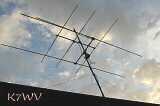
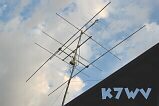
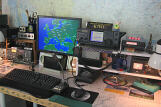
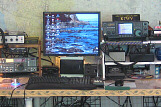
My operating
position downstairs. Click any
pic to enlarge.
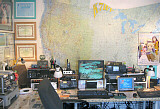
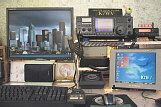
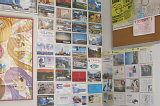
Here
is my self-designed QSL card to
go with my callsign:
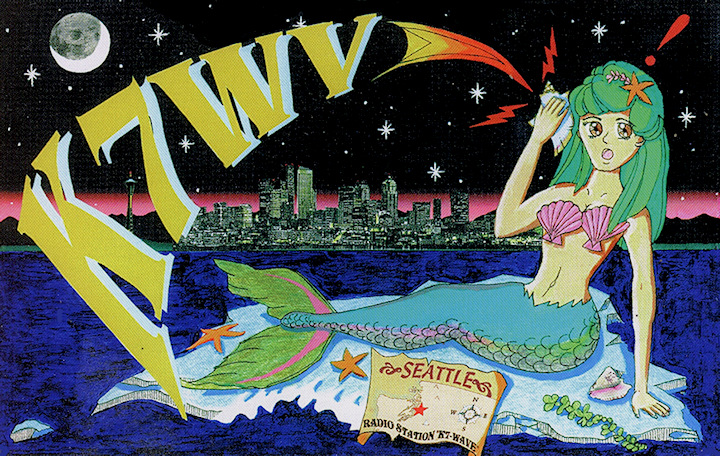
Like
one? Just work me on the air or send
a reception report!
Current
ham station
equipment:
Transceivers/Transverters/Receivers
Icom
IC-756 HF+6m Transceiver (the
original 756, a superb performer, purchased new)
Yaesu FT2500M 5-25-50 watt 2M FM Transceiver
Microwave
Modules MM 28-144 2M SSB Transverter (Mod: output doubled to
20W)
My MMT unit
Icom R71A quad-conversion HF Receiver,
Collins mech filter
mod (6.0 & 2.4 khz), 6 other upgrade mods
Wouxun
KG-UV2D
Inexpensive but decent quality HT with backlit buttons, mine
selected
for 2M and 220 Khz.
Also have the optional hand mic and programming cable.
Antennas
Alpha-Delta
DX-EE (multi-wire shortened dipole 10-40M) Used to work the
South Pole
on 20M, and 40M WAS work
Alpha-Delta
DX-SWL sloper (erected as an SWL receive ant, makes a usuable
20-80M
xmit ant)
Cushcraft
A50-3S 6-meter yagi (3-element)
DESTROYED!
Used to achieve VUCC and 49 states confirmed.
Replaced with M2 6M3,
now at QTH.
(Deployed
on rotor and operational
Jun 2014)
Pic
HERE
Homebrew
10-meter monoband yagi
(2-element, AA1DO's "Two on 10" from Apr '99 QST)
DESTROYED!
(Rebuilt as of 2014)
(Re-deployed
on rotor and
operational Jan 2014)
M2 2M7 2-meter SSB
Yagi (7-element, horizontal
polarization)
DESTROYED!
Replacement at QTH,
original
is repairable
which testifies to the M2 build
quality.
One will be deployed
vertically, dedicated for FM on a non-conductive mast.
Cushcraft
A148-3S 2-meter FM (3-element verical polarization) for
remote use, "mountain
topping".
Davis 9914F* runs for 2 & 6
meters, RG213 for the DXEE,
RG8X for the 10 meter beam.
* Replaces Belden 9913F which took on water after several
years of
excellent performance. 9914F is not hollow like 9913F.
Accessory
Equipment
Channel
Master HD/9515A
rotor (to turn above 3 monoband yagis for 10, 6, 2 meters) The motor
seized and failed after 19 years of good service. Replaced the motor
(only) with the
CM 45-12931
which appears identical and yes, the original "30-volt" indoor
azimuth selector is compatible. However, this rotor seems considerably
more loose and poorly made. It works perfectly,
but I will replace with a
reliable Yaesu G-450A in 2018. HERE
is the new rotor motor installation in place with 6-meter and 10 meter
yagis (Nov 1, 2017).
Tokyo
Hy-Power HC200AT 200W autotuner (upgrade / replacement for
MFJ 969 below)
(*This company went bankrupt in 2013. Loved the name, Tokyo being my
favorite city on the planet)
MFJ
969 roller inductor antenna tuner which works
great (now
relegated to backup
duty for autotuner above)
MFJ
921 144 / 220 Mhz Tuner (hamfest purchase)
Astron
RS-35M
35-amp linear regulated DC power supply with current and volt
meters
Pyramid PS-14K 14-amp linear regulated
DC power
supply For 50-watt FM units
Icom
SM8
Desk Mic. Discontinued, but many reports of "good audio" and
many asked which mic I was using.
Bencher
BY-2 iambic paddles on chrome base
NanoVNA H4 antenna, coax and ferrite choke analyzer
Autek
Research QF-1A
audio filter
Radio Shack straight key, all-metal "ball bearing"
type
(1971 vintage)
Hakko 936-12 Soldering Station
Davis Vantage Pro II Weather
Station with internet uplink,
Weather Underground online station
KWABRIER4
WeatherLink 5.8.2 and Virtual Weather Station V.14 Weather
Station - Internet interface
Digital
Equipment
Dell
XPS 8700 with Intel I7-4790 CPU
Dell U-2415 Ultrasharp 24-inch monitor
MFJ-1205
Rig interface for digital modes (replaces BuxComm unit below, USB connection
and cables/jumper chips available for any rig)
BuxComm
RASCAL
(original, kit) works
wonderfully but obsolete (uses serial connector)
Software: Digipan 1.6d / MMSSTV 1.04 / MMTTY
1.61 (used long ago, will download new software)
![]() Alternative / renewable power devices for remote MW/LW
DXpeditions and category 1E Field Day ops at full
100W:
Alternative / renewable power devices for remote MW/LW
DXpeditions and category 1E Field Day ops at full
100W:
This
collection of new and discontinued solar panels was acquired over many
years. They work very well together and can fully charge a
half-depleted 35
AH AGM battery in about 3 hours.
Sunsei
18-watt solar panel/ Instapark 30-watt solar panel/ 2 GoalZero Boulder
15-watt panels Total: 78
Watts. Note: now upgraded
to 90 Watts.
[The
older Sunsei
(top of pic) is amorphous silicon, the others are monocrystalline
silicon] UPDATE: The 18-watt Sensei panel was
retired as obsolete. Replacement is a modern 30W
Monocrystalline silicon. System power is now 90W and
all
mono silicon
(which is to the liking of the Genasun MPPT charge controller). My
90-Watt
Present System as of November 2020.
The Sensei panel, being
amorphous silicon, has certain low light
and hot
environment advantages and can still be plugged into the
wiring harness if desired.
Self made custom wiring
harness
connects 1, 2, 3, 4 or all of the
above solar modules in parallel and outputs to Anderson Powerpoles.
Solar
Module
Clips Quick release levers fasten panels together at
campsite or release
for easier
transport
Solar DC Power Box (MTM SPUD6-40)
with the
following built in (less
the inverter which is carried loose
inside) Nov 2020: Improvements
made to include state-of-charge meter.
MTM
SPUD6 dry box to contain battery,
charge controllers, cables, watt meters and inverter for renewable
field power
(inspired
by KF7IJZ's
video)
15A
Powerpole inputs from solar modules
and 45A Powerpole outputs from battery
Sunsei
CC10000 10-Amp
2-stage PWM-type charge controller (now the backup to MPPT controller
below)
Genasun
GV-5 5-amp true MPPT charge controller for SLA batteries only
DPDT toggle switch to instantly
switch between charge
controllers for comparative purposes
AGM-type
35 AH
deep cycle Battery (for remote field power; will operate the
Icom 100W
transceiver at full xmit power. About 210 Watt-Hrs to 50% depletion)
AGM -type 9 AH deep
cycle Battery for
Perseus field use when more portability and less overnight power is
required
Watts
Up
WU-100-B inline DC power analyzer for solar charging
measurements to
battery (solar charge input)
[In
the above linked
pic 53.9 watts is being produced and input from 3 of my solar modules
(63 watt rated) using
the
MPPT charge controller]
Turnigy
130A
backlit DC power analyzer for measuring output (power
consumption) from
battery
[In
the above linked image we see 0.43 amps or 5.4 watts being consumed by
two
Light-a-Life
camping lights]
West
Mountain Radio RigRunner 4005 Fused DC power distribution unit
Anderson
Power Poles to connect up panels, CCs, Rig Runner , battery
and power
analyzers
Samlex
300-watt
pure sine wave inverter for powering full size monitor, TV,
satellite
receiver and other 120VAC
NOCO
Genius G1100 smart charger for ultrasafe, low-impact charging
of 6V and 12V AGM and Li-ION
batteries when AC power is available, 1.1 amp max
Future:
Conversion from SLA battery to LiFePO4 battery. This will also involve
new charge controller(s). I like Genasun as they are compact and
not "sweep and
sleep" like cheaper units'
However they cannot be used for both types of
battery, they are Pb or Li specific. I may purchase a commercial power
box as they are readily available.
|
2024 Plans: Acquire Misek-Lankford
Phaser (accomplished), Acquire wires and j-kite poles for
solo DKAZ deployment |
MW
& LW
DXing
| MW Reception: |
I have been intriqued with the hobby of "DXing" (seeking distant signals) on the AM broadcast band (Medium Wave) since 1970, when I started keeping a log. I had logged 35 states and over 600 stations from both Albuquerque, NM and later on, Fayetteville, NC. From here at my home in the Seattle area I have logged over 660 stations, around 90 trans-Pacific stations such as JOZB 1512 Matsuyama, Japan at 5KW, and 3RN 756 khz Wangaratta, Australia at 10KW. In addition, 14 Alaskans and 5 Hawaiians are in the MW logbook. 36 US states on MW and on the expanded band I have heard 1KW stations on the east coast and even copied a 60 watt TIS station in Texas clearly from this QTH. Primary equipment has been the KIWA loop or large homebrew loops with the modded Icom R71A and a phaser, and as of Nov 2009, the Perseus SDR and the ALA-100M combo. SEE MW LOG
X-band:
The expanded AM broadcast
segment from 1610-1700 Khz presented for several years a clear window
of
opportunity to hear 1kw AM stations on the opposite coast. (Almost all
X-band
stations operate 10kw day/1kw night). In 1998 I logged NJ, FL, AL, GA
and
more. This seldom occurs now that around 60 stations are
operating
in the band but can still be accomplished on occasion (it helps to use
an
SDR to make lots of overnight TOH recordings). The Feb 2011 catch of
WBCN
1660 Charlotte, and WHKT 1650 Portsmouth, VA in
April 2011 are
examples.
Another window of
opportunity, the enjoyment of
listening to distant-market AM stations online has closed thanks to the
lawyers.
So once again mediumwave DXing is the only way to listen to distant
markets
with the local flavor (commercials, weather and announcements) intact.
Even
the 10" Select-a-tenna is at times able to bring in Midwesterns like
WLW,
WHO, KSTP, etc with listenable signal strength. The 12" KIWA loop does
alot
better and my homemade 42" gets stuff that doesnt even register on the
commercial
loops. For years I have been using a self-made 60-inch monster loop for
AM
broadcast with great results. Now, the outdoor Wellbrook ALA-100M
broadband loop is
outperforming everything when used with Perseus.
Updates: The 5-foot (1.5 meter) MW loop is complete and is proving it's worth with dozens of first-time loggings (Examples: KENI 650 Anchorage, CHWO 740 Toronto and around 20 Trans-Pacifics such as CNR-1 639 Beijing and JOBK 666 Osaka). Nine turns of #16 surplus wire tunes 510-1830 KHz.
The Alpha Delta
DX-SWL Sloper was installed in 2007
and is currently being phased against the 5-foot loop to enable deep
steerable
nulls using the Quantum Phaser. This has put dozens of new stations in
the
log in since I acquired the phaser. I have been able to null everything
local
except KIRO 710 to reveal stations underneath.
May 2008: I am now using the above two antennas and phaser
to feed the
Perseus SDR, along with a DX Engineering RP1-A preamp. "Drift Net
DX-ing"
is a reality with the 1600 Khz record feature!
Nov 2009: ALA-100M operational,
feeding Perseus. Five Russian
LW stations, new MW catches from N. Korea and Taiwan on a morning
referred
to as "very poor" on the IRCA email reflector. New loggings from CA and
MT
during the day, Brownsville TX on 1700 in the early evening, all on the
first
day. Some fun! Loop element oriented NW/SE and exhibiting
directionality.
Dec
2009: Added 2nd loop element E-W.
New 375-watt ND station KDDR, and KDKA Pittsburgh in the log right
away,
25-watt NDB from MI on longwave. Highly directional, like the original
loop
element. Performance eclipses anything I've ever used
here.
Jun 2010:
I have acquired an MSI Wind
U-100 netbook, quality 2GB Corsair RAM and factory overclocking BIOS.
This
opens up Perseus portable ops by battery power for full 1600 Khz
spectrum
recording to the internal 160GB drive or a 3.5" internal drive in a USB
docking
station. My unit records 1600Khz of spectrum perfectly and will soon be
deployed
at a seaside State Park. The solar recharged 35-AH AGM battery should
supply
endless power for tent camping and Perseus ops. I have acquired the
necessary
equipment to operate without noisy inverters.
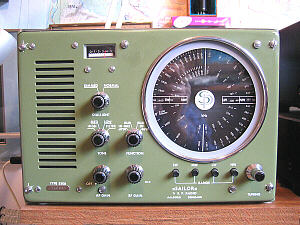
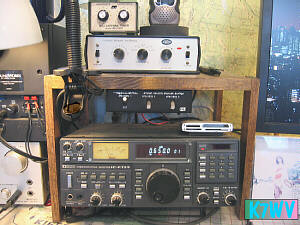
Sailor R108 marine radio
receiving KXL 750
The EEB-moded Icom R71A
and Ameco TPA
| Medium Wave Logs |
| K7WV's MW DX Log
1996-2023 from
Brier, WA QTH Approx 725 MW stations
I
have received and identified these 84 stations on the six "graveyard"
frequencies: K7WV's GRAVEYARDS
with reception distance. |
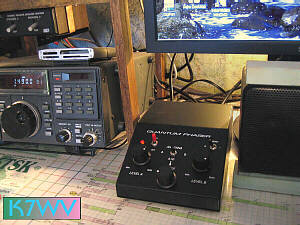 |
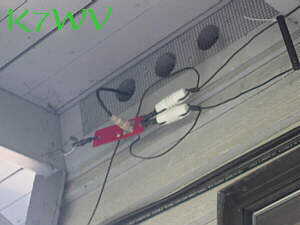 |
Quantum Phaser in operation DX Sloper Apex / Lead-In
Equipment I'm using for
MW/LW DX
reception:
Kiwa
air core inductor
loop (12" indoor antenna with remote control panel and
preamp, unit # 1376)
Palomar
Engineers LA-1 amplifier base + plug-in BCB Loop (6-inch
ferrite)
Homebrew plug-in ferrite 12" head for
longwave
(homebuilt in 1996 for use with Palomar LA-1)
42-Inch (just over 1-meter) spiral-wound
air core loop (homebrew, built for Sailor R-108)
60-Inch
(1.5 meter) spiral-wound
air core loop (homebrew)
Wellbrook
ALA100M Wide-bandwidth single-turn
loop for LW/MW DX with
Perseus, current loop: NNE/SSW. Also used on DXpeditions. Purchased in 2009.
Wellbrook
FLG100LN
Originally purchased for broadband experiments with FSLs, now in use at
the home QTH for the NW/SE loop. Also used on DXpeditions. Purchased in
2013.
Wellbrook
ALA100LN
The newest loop from Wellbrook, purchased (2017)
as a replacement for the ALA100M.
Some interior wires and a diode
broke inside
the ALA100M bias tee during a DXpedition,
rendering it
dead.
Ordered this as a replacement but I have since fully repaired the
ALA100M
and
it is back in service as good as new. I have set this up in place of
the 100M
(new, bigger NE/SW wire loop created) and dedicated the 100M
to
air
travel and experimental use (big loop on a rotor,
vactrol
tests). The ALA-100M has been withdrawn from production so I'm glad I
have a working one.
You may have noticed that I am
a big fan of these broadband loop antennas made in the UK.
They are well made and work well. 50 Khz -
30 Mhz.
NOTE:
Andy Ikin, owner of Wellbrook, has retired and these products are no
longer available for order.
Mini-Whip
antenna kits Ebay purchase of two
unassembled
kits; PA0RDT
circuit design.
PA0RDT Mini-Whip
antenna, assembled, ready to use.
This fully assembled 3-piece PA0RDT unit was
acquired
from DXer
Chris
Black (N1CP).
To be purposed for LW beacon
hunting at home and/or away.
Daiwa CS-201A Two of these 2-way
antenna
switches picked up used at a hamfest for $20. Used when the phaser
is not
needed to quickly switch antennas at the home QTH.
Common
Mode Choke 1:1 using type 77 material in a 2.4 inch toroid
for LW/MW. For DXpedition use in supressing noise.
Select-A-Tenna
10" tunable loop with mutual inductive coupling. I have 2 of these
classics.
C
Crane
Twin Coil Ferrite powered 8-inch ferrite rod for use
with ultralights for portable DX ops. Works surprisingly well.
Icom R71A
general coverage receiver, EEB High Performance Package #7
(mods include
dual
Collins mechanical filters , AGC time
constant changes,
front-end upgrade, audio section upgrade
and more). After 22 years of ownership
it was the finest
MW DX machine I'd used until I placed the
2008 order for my
Perseus SDR).
Seldom used anymore.
Autek
Research
QF-1A CW/ SSB filter, hamfest purchase, enhances audio out
using analog
filters, even helps with Perseus for NDBs
Timewave DSP-59+ Digital audio
filter works decently for CW
Sailor R108
Danish-made marine
RDF receiver (150-4500
KHz in four bands, 12-36 volt input) Picked up at Goodwill for $10!
Quality navigational unit popular with yacht owners and coastal vessels.
Perseus
SDR
I have one after ordering from Woodbox Radio in Italy in Mar 2008. 1600
Khz spectrum
record
capability
for "drift net" MW Dxing. The ultimate weapon for
MW DXpeditions! 12 years later--still the best!
Airspy HF+ Discovery I purchased
one in 2019 after 11 years with the Perseus as my only SDR. Inexpensive
and well made, it works very well indeed. Excellent DXpedition
potential on LW.
Sanshin
Electric Co. FR-662B "Coastal Navigator" Marine RDF that I
picked up at Goodwill 20 years ago, perfect classic
rig (~1970) for the "Barn
Door CLE" events we have at NDBlist.
Realistic
DX-302
General coverage receiver (My primary unit 1981-1986; inop and not
currently used;
freqency readout restored as I have
secured
several rare and obsolete
M54826P
replacement
chips) NOTE: I acquired two chips from an Australian vendor that I
found online.
Grundig
G8 ultralight with advanced DSP chip for MW/FM for portable
DX
ops. Excels at FM. My first ultralight.
C
Crane Skywave
(original) Another DX ultralight of good
reputation. Great all-around radio in a small package.
3-inch and 7-inch FSLs
shown below in Ferrite Sleeve Loop Antennas section
Aiworth voice
/ audio recording device: Records ultralight + FSL output using "Line
in"
Marantz PMD620
professional recording handheld, records to SD cards. MP3 and WAV from
"line in"
Carver TX11a
(modified to 11b standards) wideband
AM
stereo
tuner
Ameco
TPA 1980's active tunable preselector, modified w/ aluminum
internal
shielding
MFJ 16010
long wire antenna tuner
Quantum
Phaser
A well built and highly useful tool for MW DX. Some pots and switches
worn but functional. A well-built Misek-Lankford
phaser (on loan) outperformed the Quantum by a
moderate but clear margin in personal testing.
Misek/Lankford
Phaser: I have acquired my own hand-built "Misek/Lankford
Phaser 2, Version 7" from builder Everett Sharp N4CY.
DX
Engineering RPA-1 low noise RF preamp
MCL
ZSC-3-2 3-way splitter .01-30 Mhz
Alpha-Delta
DX-SWL Sloper (outdoor MW/SW antenna with resonator coils)
Dell 11 3000 series "2 in 1" netbook,
2 TB Samsung EVO
860 SSD, Pentium N3540
Sennheiser
HD 579 Headphones
"Hi-Fi" type
beats
"Communications" type for Broadcast DXing
Griffin
PowerMate A real knob for
tuning SDR radios such as Perseus / SDR-IQ.
Sola 5V 3A
Linear Regulated Power Supply SLS-05-030-1 for ultra-quiet
powering of
Perseus
with AC mains
Jameco linear regulated "wall wart" 12V power supplies (3).
Used
to fight line noise at Casa-Sea-Esta where it's very raspy.
NanoVNA H4 antenna analizer. New purchase to analyze antennas, coax and ferrite chokes.
Co-Channel
Cancellation with Airspy SDR# software (2022)
Airspy's SDR# improved Co-Channel Canceller
(2024)
See
Alternative/ DXpedition power devices shown
under Amateur equipment above
Futurlec
MiniPower 12 - 5VDC regulated converter board for quiet,
inverterless
portable/vehicle ops with Perseus
PowerWerx
USB Buddy 3A 5VDC converter from 12VDC input for powering Perseus
and phone charging. Best used with foil wrap at DXpeditions.
I attended my
first
Grayland
DXpedition
on
the coast of WA on the weekend of
Oct 20 2007. The experience was a revelation and I learned much from
the
expert veteran DXers present. It gave me a totally new outlook on what
equipment
I should be looking at acquiring/ making for future DXpeditions as well
as
at home. My first experience with Beverage antennas! To see my log
click
HERE.
After seeing SDR units in action (SDR-IQs)
at Grayland I was astounded and had to have
one.
After conducting research I purchased a PERSEUS from Italy
a few months later in Mar, 2008. This is the
future of MW
DXing. Looking forward for a return to Grayland!
Update:
Attended
a two night Grayland
DXpedition Oct 04 2008 weekend with the Perseus SDR
and full
MW spectrum
record capability. The DX rolled in on the NW Beverage. 24 Alaskans
with
ID's, over 40 JAs including 1 KW stations plus the usual S. Korea, N.
Korea,
China and Russia tier 1 stations. Also heard: Taiwan, Philippines,
Vietnam and Thailand,
all
on MW. My log is
HERE.
Big Loops I made in 2004:
|
The
42-inch (107 cm) spiral-wound MW air core loop (13 turns #20 wire and
salvaged variable cap) connected to Sailor R108. |
|
The
same design philosophy was used to build this 60-inch (1.5 meter)
monster loop. Both big loops typically far exceed the superb Kiwa Loop
gain-wise and equal it in nulling performance. The nulling ability was
a truly surprising
result considering that Litz wire and a "balanced" winding
scheme were not
used. Size matters! However the unwieldly size is also the main
disadvantage as portability is not an option. FERRITE SLEEVE LOOP ANTENNAS Ultralight
MW/LW enthusiasts have recently developed Ferrite Sleeve Loop
(FSL) antennas. Compact and portable, they perform like much larger air
core
loops. These were made by Gary DeBock in 2012 for reception enhancement
of
ultralight radios. 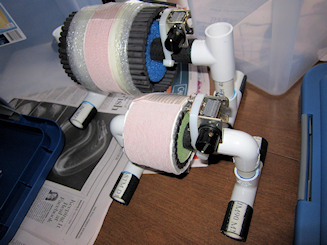 Local DXer Gary DeBock, using an FSL wound for longwave, has successfully received trans-Pacific NDBs from a seaside overlook location on a Tecsun ULR. Read about it HERE. As thrilling are the robust MW signals from New Zealand and Australia that enthusiasts are hearing from the location. As of Sep 2012 it appears that FSL's have been successfully adapted for broadbanding to an SDR such as Perseus. This is an exciting breakthrough that unlocks previously impossible DXing locations such as those cliffside pulloffs overlooking the ocean. With a Perseus and an FSL you could set up on a picnic table anywhere and record spectrum! 7-INCH FSL
02/23/2013 Update: Gary has provided me with a 7-inch FSL optimized for MW and broadbandable to Perseus using a Wellbrook FLG-100LN preamp. When the preamp arrives, I will be comparing this lightweight and compact unit at first with the non-broadband 5-foot air core loop, the KIWA loop, Palomar Loop, and the broadband Wellbrook ALA-100M (with a short wire loop to compare nulls). I should also have a PA0RDT Mini-Whip assembled by then as well. Then I intend to take it DXpeditioning to the coast. The "Rockwork 4" cliffside site in Oregon in particular should maximize the advantage of this FSL and its small profile. This FSL weighs in at 7.5 lbs.
Meanwhile, Gary is working
on a 12" FSL, one each for MW and LW, to be ready for this summer's DX
season. 02/23/2014
Having consulted with FSL creator Gary DeBock at Bruce
Portzer's
2014 DXer get-together, I will be adding a variable cap to the 7" FSL
(preferably one with vernier control if I can find one) and tuning it
like a standard loop as the broadband output with the FLG100LN is
exceedingly low as opposed to the ALA-100M and a short length of wire
(The
ALA-100M also hears LW and MW simultaneously without tuning). Direct
comparison to my
big air core loops and the KIWA can then be made (which I am most
curious about), and key benefits of
the FSL (compact size) can be exploited at ocean side State Park
campsites and
other situations where wire deployment is impractical. Gary has
outfitted his 12" MW model with large diameter Litz
wire for even greater sensitivity and equipped it with a High/Low band
switch with separate windings. THE
FSL BROADBANDING EXPERIMENT'S WELLBROOK
MODULE
The FLG100LN is the RF amp of
choice for
use with a DKAZ and other highly successful wire antennas being used at
Grayland so it has readily found new uses. My most successful Rockwork 4
DXpedition sessions made use of it, including the 2017
DXpedition and every subsequent Rockwork DXpedition
since, including 2022. It seems more resistant to adjacent splatter
than
the ALA100M and record MW/LW hauls have resulted. It again produced
record results at the cliffs in 2019, and at Grayland 2019 a month later, and
it is my main NW/SE antenna at the home QTH. I now own and use 3
different Wellbrook modules with great results. A 'BABY' FSL! 08/07/2017
This DXing style is reminiscent of my youth as a USAF Navigator in the 1980s when I used to travel with a battery powered radio-recorder and a Select-A-Tenna and tune stations overnight from places like Kwajalein and Guam. A guy approached me one night in Antigua and thought I was playing a video game (actually I was DXing Venezuelans). Mostly, you can go unnoticed. I have tested the Baby FSL against the 10-inch Select-A-Tenna and the FSL easily outperforms it. Mine
is the older
version "frequent Flier", Gary is now making them with ferrite bars;
lighter and no loss of performance. One upgrade to mine is the 384P air
variable with 8.1 drive which Gary claims offers superior tuning
performance.
Incidentally, Gary is now working
with a 15-inch monster that is probably the largest FSL in the world. I
have seen it in action. But refinements of these small ones seems to be
the current focus of FSL developers. The law of diminishing returns
appears to have made greater than 15-inch models impractical for the
size, weight and cost involved. RECENT WEST COAST MW/LW DXPEDITIONING WITH PERSEUS
08/07/2024 Rockwork
Ocean Cliff DXpedition Aug 2024 results The 14th annual, my
12th
visit and my 10th
straight year of attendance. MW results now posted. NDB
results also posted which exceeded
2023 totals and impressively favoring NZL. MW reception on
08/06/2024 was much better than last year with robust signals
and officially the most Kiwi-centric session I have ever experienced here.
Fiji One 558 was in at armchair levels yet again. Aug 07 was good for
Longwave only,
but
decent on that band with 17 Fr. Polynesians and both Cook Islands
beacons in. 11 Hawaiians on MW was rather sparse but a lot better than
Grayland a week earlier, and we only had 2 mornings here. The solar max
condx continue to take their
toll but very decent DX is still to be had.
After years of QRM the KTIL spur on 1710 (heard as far away as Haida Gwaii, BC) is finally gone, allowing renewed reception of "Part 15" station KHMB and TIS/HAR DX on 1710 Khz.
08/01/2024 Casa-Sea-Esta DXpedition (Grayland) Jul 2024 results A 3-morning coastal DXpedition with 5 DXers in attendance. The first night (Jul 30) was pretty good with at least 57 MW Australians and 37 Kiwis in for 94 DUs. The next two mornings were very poor. Results posted. There will probably not be an October 2024 DXpedition. We all have intervening issues :-( 10/20/2023 Casa-Sea-Esta DXpedition (Grayland) Oct 2023 results This is the 3-day October DXpedition to Grayland, WA that we hold annually. NDB results were outstanding to Alaska and Russia, with 33 Alaskans and 5 stations north of the Arctic Circle in. New MW beacon TF 786 from Russia heard all 3 nights. MW had some highlights too: 25 Alaskans in early in the evening on the 18th including two Fairbanks and both Nome stations. 17 Hawaiians also in for an excellent 42 AK+HI station count, only exceeded once (in 2022) by one station. Dawn on the 18th featured good AUS and NZL including a lively Australian X-Band. Interesting low power US stuff such as half-watt KHMB on 1710 Khz. That about sums up the good news. Otherwise, for Japan, Korea, Taiwan and China the conditions were well below average. Only 46 Japan stations and 11 China does not compare well to our previous October exploits here at Grayland. Sunspots take their toll at peak of cycle. 08/05/2023 Rockwork DXpedition Aug 2023 results A 4-day cliffside DXpedition with two guest DXers put 3 of us on the cliff each morning. With the sunspots hitting 20-year highs the conditions were degraded but far from absent entirely. All logs complete. We were light on MW stations, especially upper band lower powered Kiwis, but did manage a new station for me at this location: 6PNN 1152 from Western Australia. There was a surprise Pacific beacon in the NDB logs and four Australian beacons and 2 Kiwis did make it on LW. No AUS or NZL beacons heard at either Grayland DXpedition this year. We were treated to awesome full lunar sea reflections and extreme low tides this time exposing interesting sea life in tide pools after our DX session 06/30/2023 Casa-Sea-Esta (Grayland International DXpedition) 2023 results NDB log and MW logs complete. There were good and robust signals heard on high band MW and some rare stations from Australia and NZL (at least 70 Kiwis and 45 Aussies identified). Hawaiians numbered 18 and were very strong including the graveyard KEWE 1240. Just days after the Summer Solstice, a surprising 11 Alaskans were in including graveyard KIFW 1230. This DXpedition greatly exceeded expectations despite a 20 year high sunspot count. On LW a few South Pacific beacons made it including Samoa otherwise condx to the SW were poor although Alaska was good on LW too. A pleasure to DX once again with Naka-san (Hiroo Nakagawa) from the Totsuka DXers Circle in Yokohama, Japan, a guest of honor. 10/14/2022 Casa-Sea-Esta (Grayland) 2022 results (160' DKAZ at 290°) Best Japan ever, over 100 stations including the elusive MARTIS stations on 1663.5 Khz, Three Russian MW beacons and also TM 1630 from NZL. Outstanding Alaska with 30 MW and 35 LW. Best China I've ever heard with at least 42 stations. 1 KW stations from both China and Taiwan. All logs complete and posted, with audio clips added. 08/07/2022 Rockwork
DXpedition 2022 results Complete
logs posted. Aus/Nzl/Pac NDBs down considerably
from 2021.
MW: Very New Zealand centric with much fewer
Aus than usual but 6WA was in. Massive haul of Kiwis, at least 82.
Triple digits on number of DUs once again. Only 12
Hawaiians. 10/16/2021 Rockwork DXpedition II 2021 MW In Work, LW NDB results published. 38 Alaskans, 2 Russians, 26 Australians. My first good Northern Path DX observed from here with excellent AUS also. 10/01/2021 Grayland DXpedition Sept/Oct 2021 A 3-night DX session at Casa Sea-Esta. A number of unusual / previously unheard stations were in this time, particularly abundant Vietnam and Taiwan. See linked page for complete results. 08/06/2021 Rockwork DXpedition I 2021 See linked web page for my MW and NDB results. A record 85 AUS/NZL/PAC NDBs ID'd includes 35 from AUS alone. MW numbers: 83 Kiwis ID'd, 74 Australians for an overwhelming personal best. Yes, I finally did find a solid parallel for 6WA at 1312 on 8/5, a program discussing rare book prices // 4QR 612. Since I also logged 8AL Alice Springs, all AUS states were heard. The MW Log spreadsheet may be downloaded HERE for sorting or combining purposes. Otherwise see the dedicated website HERE. 10/29/2020 Grayland DXpedition Oct 2020 Another 3-night October Grayland DXpedition was held at Casa Sea Esta Oct 26, 27, 28. DXers Chuck Hutton, Jeroen Bet and myself were in attendance, with Bruce Portzer joining us for the third night. Details and results on the linked web page. 08/11/2020 Rockwork DXpedition 2020 Yes, two of us did hold one on this 10th anniversary of DXpeditioning from these Highway 101 pulloffs in spite of Covid-19 with great results. Details on the linked web page. 09/10/2019 Post-IRCA Convention: Grayland DXpedition (Sep 2019) At the conclusion of the 2019 IRCA Convention (held in Tukwila, WA this year) a major DXpedition was held in Grayland with both Breakwater Inn and Casa Sea-Esta manned by numerous veteran DXers from the US, Canada and Japan. By far the biggest DXpedition I have ever attended. I was with the Breakwater bunch for 2 of the 4 nights. In addition to the 160-foot shared DKAZ, I put up the small flag for LW action, the same setup as used at Rockwork. The Casa-Sea-Esta folks had their own 160-foot DKAZ. Australia produced personal record hauls for me on both MW and LW. On Longwave from my own dedicated LW antenna, AUS beacons were in with a vengeance on Day 2. I noticed many during live listening such as COM, CWR, even previous personal distance record holder WYY in Tasmania, now a new personal NDB distance record of 13197 km /8202 mi (Grayland is farther away from AUS than Rockwork, OR where WYY was first heard in NA a month earlier). 395 MER (49 watts) was heard for a North American "first" while trading places with PMQ on the same frequency and 401 ARM is another "NA first". Finally, 49-watt LTV 486 was found during file review, making for a 4th NA First. In all a personal record 16 AUS beacons. Interestingly, 12 of the 16 were received by me just one month earlier at Rockwork. So they are stations that get out well and make good West Coast targets. Curiously, other than the robust AUS beacons, all of the other Pacific/DU beacons fell short of the record Rockwork ocean cliffs results a month prior. 21 new beacons were added to the Grayland NDB logs (I have only had good NDB results there on one prior occasion, 2016). Results listed here: 2019 Grayland DXpedition Page (IRCA) MW results: In just two DX sessions: Over 230 DX stations! 14 Alaskans and 19 Hawaiians with IDs. Absolutely massive haul of 85 Australians with IDs is by far a personal record. ALL Aussie states including NT (8AL 783 Alice Springs) were in. The X-band was the best I have ever heard it, most frequencies with 2 AUS stations or more and audio on every channel. The unid Greek station on 1692 Khz now known to be Radio Symban, at 60 watts! At least 45 Kiwis in as well for 130 DU's, and probably more can be mined from the recordings. This blows away DU results totals at the Rockwork cliffs although here it is Australia-centric rather than NZ-centric. The elusive 2 KW "More FM" 531 Khz (Alexandra, NZ) was finally heard at a west coast location other than Rockwork although it was much weaker than typical cliffside reception. I did hear two good IDs. It has been tried for many times at Grayland and Sans Souci, Oregon closely timed to the early August Rockwork DXpedition but not heard anywhere else in North America until now. Fine showing of Pacifics with both Kiribatis, Tuvalu, Fiji, Tonga, Guam, Marshalls and so on. Japan reception definitely subdued with slightly over half the usual station count (33 heard) of a typical October DXpedition here. Some N/S Korea and China also in but the prominent "big gun" stations only. MW results with audio clips are now up on the dedicated website. On the day after I departed the guys were treated to excellent Alaskans including the Fairbanks area stations (KFBX, KJNP etc) not heard by me since the 2010 Grayland DXpedition. Too bad I had to cut it short at 2 nights due to lack of vacation time from work. There were 9 DXers in attendance so pre-DX we enjoyed some "Shortwave" (the beer from B.C.) and comparison demos of the Airspy HF+ Discovery with Perseus. Totally convinced, I bought one for dedicated DXpedition LW monitoring so I will not need to choose between the DKAZ and the LW flag (and missing DX) in the future. The unit has proved very effective on LW, perhaps a bit cleaner than even Perseus. Most of my peers are already using 2 SDRs or more at these DXpeditions so now I will too. Even live KiwiSDRs are being set up these days for remote DXpedition listening by non-attendees. And as if that was not enough, Nick set up his online "DX Fishbarrel" DX spotting tool at the site as well, which made for some interesting compares with Victoria at the same time. Results, audio clips and pictures are up on my dedicated website: 2019 Grayland DXpedition Page (IRCA). At this years IRCA Convention in Tukwila, WA I was invited to give a presentation about these cliffside DXpeditions. The powerpoint and recorded audio of the talk are available HERE. Go to the 'Seattle 2019' section at the page bottom. 08/08/2019
Rockwork
DXpedition 2019
I
attended for 5 mornings again this year and encountered astonishing
LW NDB reception along with Gary (who wisely switched over to beacon
hunting on the two hot mornings), it was great fun with record results
from both styles of DXing. Last year's
phenomenal NDB total was well exceeded, 8 NDBs never
reported heard from North
America, and an initial personal NDB distance record of 12907 km
(8020 miles) on a beacon of only 49 watts.
The brief
antenna reorientation towards the NW on a couple mornings also paid off
with NDBs received from Alaska to Iwo Jima to Russia and loud Japan MW
big guns.
MW compilation had to wait until the IRCA Convention
and it's related DXpedition to Grayland concluded.
Those final results are posted HERE. Once again I was able to
DX from Rockwork
4
exclusively for all 5 mornings. The interlopers were not the force to
be reckoned with
that they were last year, and I was able to share the available set-up
space with Craig and Gary (and some of the largest FSLs
in the world) all 5 mornings.
Record DXpedition NDB Results: K7WV NDB distance record extended to 13147 km (8168 miles) with solid ID from WYY 302 Wynyard, Tasmania (AUS) on Aug 06. Aug 06 was best for AUS while Aug 08 was best for NZL on LW. My NDB results smashed all previous NDB records for a West Coast DXpedition. 10 NZL, 3 AUS and 1 OCE never reported heard from North America. 73 DU / Pacific beacons, a 17 station increase over last year's record, including a record 14 from Australia and a record 18 from NZL. Even here, NZL won out over AUS! The amazing haul from NZL represents 72% of all beacons operating in that distant country. We were also rewarded with ALL known beacons from French Polynesia having been logged from Rockwork. Results with audio clips here: August 2019 Rockwork DXpedition Page. Medium Wave results are posted to the above linked page. Not quite the same record-breaking results here, just slightly off from recent years but still very good. Above 1300 khz it was a bit thin with only around 17 stations in audio over the 5 mornings, and rather weak signals as well. PACIFICS: 16 Hawaiians, Tonga and Fiji, (same as prior years), plus V7AB 1098 at signoff with the Marshallese anthem. ASIA: 11 first tier Japanese, a couple S. Koreans and the 1143 Khz Taiwan Fisheries station in this time, seldom heard during the first week in August. AUS/NZL: 101 DUs overall, 65 Kiwis and 36 Aussies (7 to 4 ratio) which is solid (similar number of Kiwis as last year and just 7 short of my personal record) but overall the hoped-for improvement during the solar minimum did not materialize mainly due to an underperforming upper band. Low band (and especially LW) was king. Results here: August 2019 Rockwork DXpedition. You will always come away with more Kiwis than Aussies on MW here, and 2019 was no exception (see graphic below). The 100 Kiwi MW DXpedition remains an unachieved possibility for future DXers to try for from the NZL-enhanced cliffs. If it happens, it will be here! Update::
I am booked into Manzanita for 4 nights in early Aug 2020. Unknown if
guests will be accepted due to COVID-19 but Gary and I plan to be at
the cliffs once again! The action is too good to ignore.
10/15/2018 Grayland
DXpedition (Oct 2018)
I
attended a 3 night DXpedition at Casa
Sea-Esta,
the furnished rental house just a short walk from the old Grayland
Motel, with veteran DXers Chuck and Bruce. We set up the 160-foot DKAZ
out back and even used a vactrol for
the first time which definitely proved beneficial. Propagation was not
as great as
expected on MW or LW. Not a shut out by any means, but more numbers and
exotic fare was expected
during "bottom of the cycle" conditions. Unfortunately there
was also a lot
of QRM as
we set up too close to the house, as confirmed by Bill Whitacre who has
DXed from there often and sets up on the beach side of the berm with a
400' lead-in coax. We did mitigate the noise somewhat on Day 2 and 3 by
turning off switches all over the residence. Even so there were some
surprises such as 17
Alaskans on
Day 3 (only), 990 Gold FM from Fiji, an excellent ID from 1575 Misawa
"The Eagle" and a robust 1440
Kiribati. Also 53 JA's is actually pretty good although we were about
there or surpassed that in 2015 and 2016. For the first time we had
"graveyard" stations in from both AK and HI likely due to the vactrol.
LW was unimpressive with
just a few
of the more prominent Pacific Beacons like AI 320 and PNI 366 being
audible. LW DGPS yielded
just two
Aussies (of the expected 6). Australia /NZ/Hawaii MW numbers were much
reduced from previous years. Upon listening to the MW recordings for
logging purposes, the
results proved to be somewhat better than my original impression, and
the
QRM less overwhelming, resulting in some good audio clips to be
posted with the log on a dedicated web page. We have already produced a
combined 3-DXer
log that Chuck reported to the DX community HERE. My updated log may be viewed
in detail here along with some pics and many audio clips: October
2018 Grayland DXpedition
Page.
On a related note, as urged by Bill Whitacre, we visited the new owners of the (former) Grayland Motel and they are almost done refurbishing the cottages, which look nice inside and out. The Motel, now called the Breakwater Inn, is projecting a "Spring 2019" reopening. They seemed pleased to have DXers stay there and no objection to erecting antennas during their stay. The new owners are electrical contractors and are totally re-doing the electrical setup themselves so we will have to assess noise at the site with a tryout DXpedition after they reopen. 08/08/2018
Rockwork
DXpedition 2018
I
attended for 5 mornings this year and caught outstanding conditions,
especially Aug 05, 07 and 08. Curiously and due to "squatters" and
limited space, I was the only DXer of the five present to use Rockwork 4
exclusively. Rockwork 3, 5, and 6 were all used by my partners with no
apparent effect on results.
LW: August 7th and 8th were by far the best for longwave; they were in fact the only days that mattered for NDBs. I thought the 5th was an excellent morning but not so much for LW. The longwave NDB haul is absolutely bedazzling as I have already identified an amazing 56 Australia/NZ/Pacifics (crushing last year's record 39) with 6 stations being first ever loggings from North America, and one being a 2nd-time logging (first heard in 2009). The results may be viewed here: August 2018 Rockwork DXpedition Page. Featured is my farthest ever NDB reception: 332 BHI, Broken Hill, NSW Australia at 7965 miles (12816 KM) and the power is only 100 watts. We also had 6 Australian DGPS stations in solid, and a 7th loggable (a North American "first"), a record haul from DU-land. While onsite I had no idea it was this good. Gary picking out NF-260 on an ultralight on the 8th (for the first time in years) was, it turned out, a great indicator. MW: Results include 17 Hawaiians identified. One more than last year, and as most mornings include just one TOH opportunity, it's probably the best that one can do cliffside with small portable antennas. "Down Under" MW DX was as impressive as LW with 64 Kiwis and 45 Aussies ID'd, 109 DU's. There were more Australians than I realized, more than received last year, with unusually good reception to South Australia. But again, NZ stations outnumbered AUS by a 7:5 ratio, thanks to the curious NZ-favored cliffside enhancement.The completed MW log is now up and may be viewed on this dedicated page: August 2018 Rockwork DXpedition with numerous audio clips. I am booked for Aug 03-07 2019 for another round of this impessive cliff enhancement. 08/02/2017
Rockwork
DXpedition 2017
I
attended for 6 mornings this time and caught outstanding conditions on
several mornings, particularly the 4th and 5th. My partners were Gary
DeBock and Chuck Hutton. My results are now available on this
page: August
2017 Rockwork 4 DXpedition
Page.
MW and LW logs are posted, with numerous MP3 audio clips. 72 Kiwis and 41 Aussies
made for
113
DU's on
medium wave at the cliff, a new personal record by a wide margin.
A 7 to 4 ratio, as always favoring the Kiwis.There were 17 Pacifics
heard, including 16
Hawaiians plus Fiji. I did
not set
up early enough to go after Tonga or Tuvalu (One of the restrictions of
"cliffhanger" DXing is that you must set up and tear down for every
session, so no overnight timer recording). DXpedition partner Gary DeBock
shared in the bounty and now holds the Ultralight World
Record for
reception of a 10 KW signal with the unexpected appearance of 531 6DL
on Aug 04.
The longwave results were just as impressive as MW, with a record total haul of 39 DU and Pacific beacons to include 14 of the elusive French Polynesia beacons, plus two Aussie DGPS decodes from Victoria and South Australia that are North American "firsts". The first week of August appears to be the optimum time for this DXpedition and we are scheduled for the same week in Aug 2018. The NZ-centric enhancement offered by this site is for real (7:4 ratio of NZ to AUS stations in 2017) and hopefully we will encourage more SDR and ultralight DXers to consider a Manzanita, OR vacation in 2018. 10/16/2016
Grayland
DXpedition (Oct 2016)
I attended a 2-day
DXpedition with Chuck and Bruce at the Grayland Motel
as is usual for me during October (but apparently for the last time).
The so called
"Storm of the Century" (which
did produce a tornado at the other DXpedition hotspot: Manzanita, OR)
did not
dissuade us from erecting antennas. While no one wanted to set up a
Beverage in these conditions, we set up a 160-foot DKAZ at 270
degrees true as we did last year. The morning of the 15th had the MW
band full of Filipinos which was most unusual. Chuck and Bruce found 16
while on site in
one recorded file. Also some good Japan as the K-index actually dropped
to K=2 that morning, and vast numbers of loud Aussies. The
next
morning
on the 16th was terrible during darkness, not even Hawaiians were in.
Bruce actually
went out and checked the antenna. I went back to bed but came back in
for possible dawn enhancement. Wow, we sure got that and now conditions
were outstanding. About 1 wonderful hour of Japan and Hawaii, absent
earlier, and louder than Day 1. Good IDs from KIPA 1060 Hilo (relaying
"102.7 The Beach"), 22 Hawaiians in all, a personal record haul. JOLF
1242 was in long after sunrise and still going well at 15:30 UTC. K=3
that
morning. The complete logs are now posted on this dedicated
page: October
2016 Grayland DXpedition
Page.
Conditions exceeded
last year in every way with over 65 AUS/NZ, over 20 Philippine
stations, well over 50 Japan and vibrant Pacifics such as Marshall
Islands, Tuvalu, Guam, Tonga and even Yap, Micronesia. The only
downside was static crashes on Sunday from the storm. See 2-year
comparison
chart below: Very
similar propagation numbers but a little more "magic"
happened in 2016.
As
a special
side project, I also erected a delta loop with 17 feet per side, feeding a
ALA100M for Long Wave action. Results were outstanding with a
personal record 7
NDBs from
mainland Australia including a couple never reported heard from North
America, HN 242 from Hawaii only heard outside Hawaii
once
before in 2005, two from Fiji, Norfolk Island, Kosrae and
Pohnpei FSM, two from the Marshall Islands, Iwo Jima, Minami
Tori
Shima, Midway, Nauru, Soloman Islands, Rarotonga, four NZ, Samoa and
more.
Also, four Australian DGPS stations were in with hundreds of logs each,
two of them never reported from North America. Also in was TM 1630, the
New Zealand MW aero beacon, heard on the DKAZ. Results posted to NDBlist
and DGPSlist.
Not in were the 16+ French Polynesian beacons heard from Rockwork 4
last year. In plotting the catches the antenna turned out to be
exceedingly
directional and needed to be reoriented more southward to get
those. The directionality also explains the Rockwork 4 longwave
results in which the Western Pacific went mostly unrepresented in lieu
of
massive Fr. Polynesia beacons. Now I know to reorient. And
one
last
thing: The Grayland Motel ceased operating in Feb, 2017 so it looks
like this will be my last DXpedition from there, ever.
A 30+ year West Coast tradition comes to an end. There is still
Grayland State Park, but more austere conditions and not exactly DKAZ
or Beverage friendly. A search is underway for a replacement, possibly
the "Casa Sea Esta" rental property
used by Bill Whitacre. Bill has used a DKAZ and even 1000-foot BOGs at
the location and recorded great results, just 800 feet SW from the
Grayland Motel. We plan to
hold a DXpedition of some kind in/near Grayland in Oct 2018.
07/11/2016 Rockwork DXpedition July 2016 I attended a 3-day International DXpedition at the Oregon ocean cliffs where as an American I was outnumbered! Two Americans, two Japanese and one Canadian collected DX by various means including SDRs and FSLs/modified ultralights using very different small-footprint antennas. My overall impression was that propagation did not reach the amazing levels of my previous two trips there last year in June and August, but there was still much to hear and much fun and comaraderie to be had. My results may be viewed here: July 2016 Rockwork 4 DXpedition (K7WV results). Over 50 DU signals (41 NZ) on MW along with 14 Hawaiians have been ID'd so it was far from being a shutout. Audio clips and pictures provided. 10/11/2015 Grayland
DXpedition (Oct 2015)
I attended a 2-night DXpedition in
Grayland, for the first time using a DKAZ
with FLG100LN and fixed termination in lieu of the usual Beverage. It
worked just great and I was very impressed, especially as we "split the
difference" with a 270 degree due west orientation, meaning neither
DU-land nor Japan were on boresight and yet stations under 1 KW were
heard from each. Japan received on 50 frequencies, best Hawaiians I've
ever heard outside the Islands with 20 in nicely with IDs including
Hawaii's "graveyard" station on 1240 all alone. Over 40 Aussie and NZ
stations
"off season" in October was a wonderful haul and the clear ID
from KGUM Guam would have to be my best catch. However China and the
Koreas were practically absent, as was Alaska. The other downside was
no LW, the DKAZ was very low output there. Overall though...great
antenna! My log
is here, complete with audio clips: October
2015 Grayland
DXpedition Log.
I joined Chuck Hutton, Bruce Portzer and Chris Black (N1CP) for this
2-night session at the famous DX locale The Grayland
Motel. I
have been DXpeditioning there annually during an October weekend since
2007. 06/28/2015
Two
Rockwork
4
DXpeditions in 2015 Links
to my web pages created for my participation in the two ocean cliff
DXpeditions in June and August,
using a 3-sided delta loop 13' per side made from
40 feet of wire and some tomato poles as spreaders, amplified by the
excellent ALA-100M. Very small antenna produced
big results beyond my expectations on both MW and LW. Attended with
Chuck Hutton and Gary DeBock. I have now acquired fiberglass spreaders
and a new Dell "2 in 1" small laptop with a mobile quad core Pentium to
replace the Atom N270-based netbook used with Perseus that could barely
operate it at full bandwidth with 24% overclocking. I want to get more
wire in the air directionally next time as well, much more and I will
need to switch
to my FLG100LN as the amplifying module as the ALA-100M approaches
overload with around 45 feet of wire. Pics, my logs, audio clips and
comments for each of my 2015 sessions are posted at these links:
June 2015 Rockwork 4 DXpedition (K7WV results) August 2015 Rockwork 4 DXpedition (K7WV results) |
|||||||||||||||||||||||||||||||||||||||||||||||||||||||||||||||||||||||||||||||||||||||||||||||||||||||||||||||||||||||||||||
| LW Reception: |
Longwave is generally defined as those frequencies below 530 Khz. In Europe and Asia broadcasting occurs in the band, but in the Americas the region 198-530 Khz is primarily reserved for aeronautical navigation beacons called NDBs. These are a DXer's dream as they continuously identify themselves with a slow Morse ID. Although GPS has seemingly obsoleted these beacons, no politician wants to be the one to turn off a backup safety system so most should remain for years to come. DXing them has become a challenging niche of the radio hobby. Other activity on the band includes DGPS, NAVTEX, and amateur experimentation. The Longwave Club of America has lots of info on this overlooked band. I caught the NDB DXing bug in 1995 when I built the homebrew 12" plug-in ferrite loop pictured below for the Palomar LA-1 base, left.
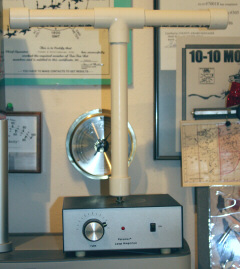 |
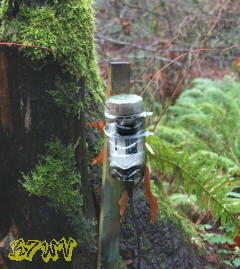 |
I
began longwave DXing at
this QTH still using the
Palomar Engineers LA-1 amplifier-base and a 12-inch ferrite loop that I
designed
and built myself back in 1994 that plugs into the LA-1 (A 6-inch
commercial
LW plug-in loop is available). The S9 noise that prevented
reception
here for years abated enough that I could receive lots of NDBs thru the
lowered
noise floor. Here is the cumulative beacon log started Summer
2001:
![]()
Beacon Log stats: more than 635 Aeronautical NDBs and 10 Amateur LW beacons received from 12 Canadian provinces/territories, 33 US states, Mexico, numerous Caribbean and Pacific islands, the South American continent (Equador) and even Russia. I've actually received more Alaskan beacons (54) than from any other US state, and have more Canadian NDBs in the log than from the "Lower 48". Most distant received here: SON 412 Khz, Santo Pekoa (Vanuatu) at 6147 miles (9893 km). All NDB's received at the K7WV home QTH and ID'd by aural means only (audio ID of morse callsigns by ear, no sonograms or visual means used to date). Tools used are the Perseus SDR, Perseus V5 software, Studio One, HDSDR (free software), and the ALA-100M with several directional loop elements (which are just ~50-foot lengths of wire loops assembled among trees in the back yard). Oct 20 2017: Now using opposing loops, the NW/SE one amplified by the FLG100LN and the E/W one by the ALA100LN. The original ALA100M continues to be used at DXpeditions and for future rotor loop project, it is still going strong.
In January 1996, an early test of my self-designed ferrite loopstick LW receiving setup at a quiet location in Albuquerque, NM (DM65pe) using the Icom R71A yielded 100 beacons in 17 states in one 2-hour session. To view that log click here. Compare with Perseus / ALA-100M log from the exact same location 18 years later: click here. Note that the homebrew ferrite loopstick/Palomar Engineers base is pictured above.
Update
Nov 15
2009:
Five Russian
R.
Rossii longwave
broadcast stations (which I had heard before only at Grayland) were ALL
in
the log within minutes of activating the new Wellbrook ALA-100M for the
first
time here at the QTH. At last, a quiet S2 noise floor on LW thanks to
the
remotely located loop and this innovative product. 279 Khz was
"armchair
copy" like a local.
| -Freq- | -Transmitter- | -Power- |
| 153 | Komsomolsk | 1200 KW |
| 180 | Yelizovo | 150 KW |
| 189 | Belogorsk | 1200 KW |
| 234 | Arman | 1000 KW |
| 279 | Yuzhno-Sakhalinsk | 1000 KW |
Note: In the subsequent seasons I have logged additional LWBC stations from the Far East, such as Radio Rossii 171 Yakutsk (150 KW) and Mongolia on 164 Khz (Mongolyn Radio 1 500 KW).
Update
Sep 15 2015:
The Russians have ceased
all broadcasting on LW
and almost all MW outlets in the Far East. End of an era.
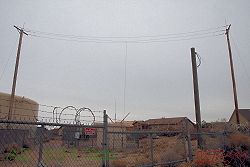
Note: The 2-letter ID denotes a Compass Locator (ComLo) or co-located Marker Beacon for an ILS approach. In the case of an Outer Marker/NDB combo, it is called a LOM (Locator Outer Marker) and takes the first two letters of the airfield ID (which is AEG in this case). The vertical wire is the only radiating element, and is omni-directional. The three horizontal wires between the wooden poles serve as support for the vertical element, and as a capacitive "top hat". The small cinder block building houses the 25-watt (or less) transmitter and antenna coupler. Note the 2-foot lightning rods atop the wooden poles for lightning protection, and the sloping wires to ground. I have heard this station from my QTH in WA, 1181 mi /1901 km distant. It has been reported heard as far away as OH and MI. Updated photos taken January 2017. Click on pic for a larger image. HERE is another closer view of the transmitter and vertical radiator. A closeup of the transmitter cabin is HERE. The "V" shaped red yagi array is for the 3-watt, 75 MHz signal to illuminate the "outer marker" light on the ILS panel in the aircraft. The pilot "homes" to this point using AE, then switches over to ILS (Instrument landing System) to begin his instrument approach. The ILS glideslope and localizer transmitters are located at the airfield.
I
have many other NDB photos, of numerous Alaskan NDBs in
particular. These
can be seen on the NDBList website under Photos.
NDBs:
After years of inactivity due to constant local S9 noise on the band, I resumed actively hunting NDBs in 2009, thanks to the ALA-100M and Perseus. Some spectacular results can be seen in the K7WV home QTH BEACON LOG where around 70% of all beacons heard have been added since deploying the ALA-100M in Nov 2009. Locating it remotely from neighbor noise was a major breakthrough.
These
NDB's (well over 100) received during 'daytime'
(within 2 hours of local noon) at K7WV: Daytime
NDB's
Jan 10
2012:
SECONDARY
QTH:
For
the past 5 years I have made
numerous 2-minute MW / LW Perseus recordings from
Albuquerque,
NM,
1180 Miles distant from my
WA QTH, from late December to early January coinciding with holiday
visits.
The Wellbrook ALA-100M was deployed in 4 different loop orientations.
The
ABQ
NDB log
may be seen
HERE.
More
than
465
beacons in 33
states
including HI, numerous Caribbean
islands, Central and South America,
11
Canadian provinces/territories and
4
Mexican states have been identified to date. The ABQ NDB log and the
Beacon
Log from my home WA QTH have a surprising number of stations in common.
The
ABQ NDB log serves well as
a list of known, operating
DX targets to try for from WA. Now ready to send up to
RNA
for inclusion in the
database.
In addition to the above log, using a loopstick of my own design, a
Palomar
Engineers LA-1 Amplifier/base and the modded IC-R71A on Jan 4, 1996, I
compiled
this 100-station log from the exact same location : ABQ
NDB 1996. This
pre-DGPS
log
is interesting to compare to the modern log above, especially the
285-325
Khz range.
Aug 07 2010: At local midnight in a parking lot next to my hotel in Litchfield, MN I made a couple 2-minute 1600 Khz bandwidth recordings using Perseus and the MSI Wind Netbook on battery power. LW was noisy (S5 - S7) due to incoming T-storms, and auroral conditions were in play, resulting in just 60 ID's. Still enough to make a useful beacon log. View it HERE. Loop directionality was N/S. Aside from the two NC super beacons and one QC, all stations heard were from MN and surrounding states/provinces. Mediumwave was much more productive.
Sep 22 2010: Membership in the NDBlist group to share and compare beacon hunting results with fellow enthusiasts. I was already using their superb RNA listing to ID beacons but needed to convert all my logs over to their NDB Weblog system to be included in it. The logs from my primary WA QTH are now in RNA as of Oct 2011. WWSU was very useful in accomplishing this. The New Mexico logs will go up next, with around 460 beacons ID'd at that secondary QTH.
Mar 11
- 12 2011:
I
made a series of full MW
+ LW Perseus recordings from
North
Charleston,
SC.
The MW band was loaded with
Cubans and there was a Havana beacon in the quick LW check I made. When
I
get the time I'll put together a beacon log from the the LW band
recordings.
Unfortunately inverter noise will severely limit this log as it did the
Litchfield log above. I have since procured a 5 VDC downconverter for
12
VDC source which is inverterless and proven quiet with Perseus.
Nov
28 2012:
Acquired
two "Mini Whip"
antennas of PA0RDT's design on Ebay in kit form. Those on the NDBlist
that
have already built it are reporting excellent results on LW and MW.
Most
beacon hunters are using mini-whips and report superior results over
my current antennas of choice: Wellbrook
loops. One of these will be deployed at the primary QTH and the other
used
for DXpeditions. You can even
try
one out online in Europe by clicking
HERE.
They work very well indeed for NDB work.
May 22 2013: Tried to make some Perseus recordings from Key West, FL with the ALA-100M and found the perfect spot to set up but had difficulties as I was missing some cables and suffered a blown fuse on the ALA-100. Still managed to make two 5-min full spectrum recordings during the daytime which are fascinating with Cubans everywhere. Hopefully I can find a good airfare sometime and return to do it right.
Feb
24-27
2012:
I participated in a Coordinated
Listening Event this weekend decoding
Differential
GPS
signals on longwave, 285-325 Khz.
Result here was 43
stations successfully decoded
including 4 AK and 2 HI and as far east as Michigan, approx 1/3 of all
stations
receivable from North America. Intriguing enough to keep experimenting
with
software and DX the mode from time to time. I have also joined
DGPSlist.
When I discover how to setup for playback of Perseus WAV files, I can
mine
past recordings made during the solar minimum, and from the Albuquerque
QTH.
UPDATE
APR 2014:
Another
DGPS CLE is coming up and
my favorite decoder Spectrum
Lab 2.79 b13 (freeware) is working perfectly for me, now
supports Windows
versions beyond XP and has additional useful modes like Hellschriber
and
QRSS. The other two popular decoders are not freeware,
Multipsk
and
DSCdecoder,
but offer
much improved ease of use. Still not set up to play recordings and have
to
operate "live" on this mode.
--K7WV's DGPS
Decodes-- Late April 2014's
CLE181
is complete and increased to 49 DGPS stations decoded total. Got Cape
Hinchinbrook,
AK two mornings in a row and am the only list member to decode this
station.
I also experimented with antenna phasing and had good results nulling
the
dominant to expose underlying stations in a couple situations. I tried
DSCdecoder
installed on an evaluation basis to try to decode recorded Perseus
files
using sound card input. Using my Alaskan Perseus recordings, it decoded
all
9 Alaskan DGPS stations.
Notice--Aug 2015: The Coast
Guard is proposing the decommissioning of most inland and numerous
coastal
DGPS stations. Reasons include lack of DGPS adoption of commercial GPS
makers
in favor of WAAS and declining use in the maritime industry. Bad (and
good)
news for
DGPS fans
but all good news for NDB DXers. After years of cursing DGPS I learned
to
love
decoding it.
Feb 14 2016:
My first sampling of the
mode since they started
turning off stations. Got my
50th DGPS
station tonight
with Hartsville,
TN on 317, a result of Alma - St. Paul currently operating at reduced
power.
Everything appears to be still on with only 290 Pahoa, HI and 292 Cape
Hinchinbrook, AK being decommissioned so far.
Sadly, these were
two of my favorites and all the pests remain.
Aug
05 2016: 37
DGPS stations have just been permanently decommissioned. It's for real
this time and it includes several pests. It is possible to
decode
Potato Point and Kenai (Alaska) now if we get a nice low K-Index some
night. UPDATE:
I have already received my first new station to be unblocked by the
decommissioning. #896
Kenai, AK 310 Khz (ref id=292)
was decoding nicely with a K index of 2. It will most likely take a
K-Index of zero and an exceptional night to decode the weakest and only
remaining AK station to be decoded here, Potato Point. My revised log
shows the new catch and those stations logged here that are now
decommissioned. Of the 51 previously logged only 28 are still
operating. 12 new ones have been logged since Aug 2016 on newly opened
up frequencies
resulting in 63 stations logged.
Oct
07 2016: Using the wonderful new Amalgamated DGPS
software for the first time, it works great for me using Win 7 /
64-bit but only with I/Q
recordings so far (not live Perseus for unknown reasons). A big
breakthrough in DGPS
reception, it decodes the whole band at once and only Message 6's and
9's can be selected for accuracy. Oct 08 2016 was an unusually clear
night and I wound up with five new ones from the East Coast by making
numerous 10-minute recordings. These and more have been confirmed with
numerous repeat receptions since. I have adopted 10 decodes
as a minium
threshhold for logging consideration (other things have to
check out
too) but have had some bizarre stuff hit 8 and 9.
Nov 21 2016: On
the same exceptional night noted in the NAVTEX info below,
Potato
Point, AK was decoded from CA. Always thought I would be first with
that one. I have just had a breakthrough and got the impressive Amalgamated DGPS
decoder working for live
decodes so with overnight runs commencing it is only a
matter of time. Nov 24: #895
Potato Point makes it at last! Finally I have decoded all 9 (including
2 decom) Alaskan DGPS stations from the home QTH.
Dec 05: Potato
Point was in again with over 100 decodes from around 30 minutes of
overnight recording intervals. It takes an absolutely exceptional
night as this was. 35 Alaskan NDBs were in this morning as
well, and even
Russian beacon 437
OG!
Oct 16 2016:
The Aug 2016 Grayland DXpedition LW experiment using a
dedicated
delta loop and ALA-100M for Longwave brought in 4 Australian DGPS
stations with approx 1000 decodes each using ADGPS. Two of these are
North American "firsts". Details here: 2016
Grayland DXpedition Page
Aug 05 2017: The 2017 Rockwork 4 DXpedition using a 60-foot circumference delta loop and FLG100LN brought in 5 Australian DGPS stations with from 26 to over 1700 decodes each using ADGPS. Two of these are again North American "firsts". Details here: 2017 Rockwork 4 DXpedition Page
Notice--Aug 2018: The US Coast Guard has finalized their plan to decommission ALL remaining DGPS transmissions in the USA over the next three years. Decommissionings will be in phases.The schedule is HERE.
Aug 08 2018: The 2018 "Rockwork DXpedition" at the Oregon cliffs near Manzanita resulted in a record 7 Australian DGPS stations decoded. Details here: 2018 Rockwork DXpedition Page
Aug 08 2019: The 2019 "Rockwork DXpedition" featured solid receptions of the same 5 DGPS stations each day. The more northerly focus meant getting Cape Flattery instead of Corny Point. Results: Rockwork DXpedition 2019
Sep 10 2019: The 2019 post-IRCA Convention "Grayland DXpedition" featured Corny Point in but Cape Flattery and Gladstone out, using ADGPS at dawn. 2019 Grayland DXpedition K7WV results
May 10 2020: Australia
to decommission all DGPS transmissions July 1, 2020. It's
been a fun part of the Grayland and Rockwork DXpeditions. With today's
receivers using satellite-based augmentation there is no need to
continue with it.
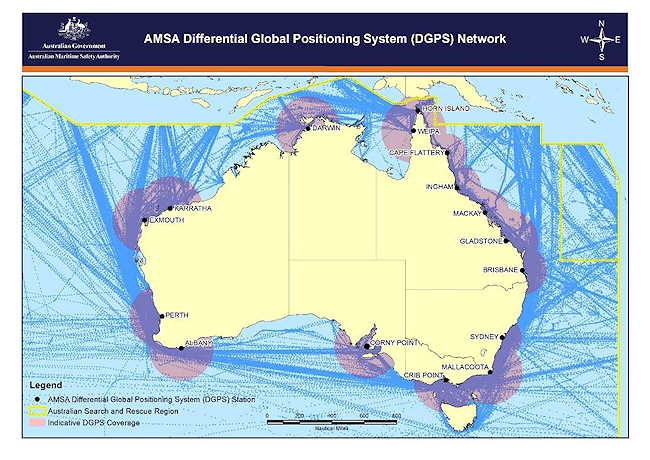
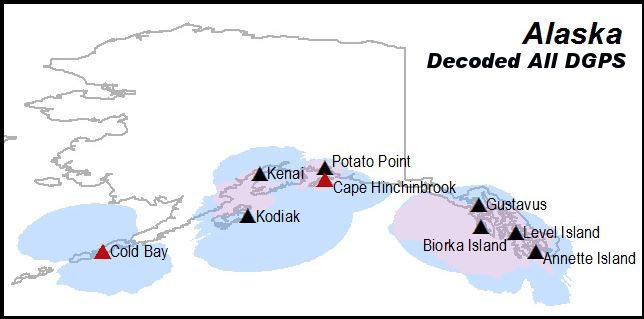
NAVTEX:
Apr 02 2013: I completed my first NAVTEX CLE in which I used YaND (freeware) to decode marine navigational alerts and weather from 518 Khz longwave as well as several SW frequencies. Here is my log containing the CLE (black text) and subsequent decodes (blue text), currently with 50 stations decoded: K7WV Navtex Log. Looks like I have found another mode to enjoy and DX! I joined the NAVTEX section of Yahoo Groups NDBList to be able to send up logs to the RNA database. UPDATE: I am still using YaND 6.4 and consider it the best decoder available for this mode. The NAVTEX group is now HERE.
A NAVTEX-J decoder is needed to decode the 424 Khz stations transmitting in Japanese text; for that task I am using Frisnit 2.1.5-J which is free and really works, but lacks YaND's sensitivity and understandably must decode vastly greater character sets for the Kanji, Katakana, Hirigana and Romanji text fonts. So far I have only successfully decoded the two stations in Hokkaido which are nearest to my QTH: Otaru and Kushiro. See Example of decodes received at K7WV.
CLE192 has concluded, having taken place exactly 2 years after my first NAVTEX CLE. This time only 490 and 518 Khz were in play. I have never received a decode on 490 so I concentrated on 518. I received every station I have ever received on the frequency except Kushiro, all on the last day of the CLE when conditions became quite good. Had to wait until dawn for the night path to Japan to occur and which only lasted minutes at the end of March but was rewarded with JGC Yokohama and JNB Naha. YaND 6.4 was the decoder of choice.
Nov
21 2016: An exceptional night on 518 Khz
brought in Trans-Pacifics JNX
Kushiro, JNL Otaru, JGC Yokohama (at both 9:20 and 13:20)
and JNB Naha
from Japan, and HL*
Chukpyong
from S. Korea overnight with clear decodes. Otaru and Chukpyong
all-time new for me and Chukpyong not reported by anyone in 5 years.
There were bits and pieces of even more stations, apparently from
Vietnam. Really
enjoyable to have a night like this with YaND 6.4 performing
wonderfully.
Mar
18 2018: JNR Moji (Kitakyushu) Japan
was decoded overnight on 518 Khz with 7 perfect messages. I am the
first DXer to decode this station from North America.
Oct 30 2018: An exceptional night of superb conditions brought in all 5 Japan stations on 518 Khz twice during the night around 0900 and again around 1300. In addition 3 new ones had good decodes for the log: XSW Kaosiung, Taiwan, UFO Kholmsk, Russia and XSG Shanghai, China. Good to perfect decodes on all. Kholmsk is a first ever reception for North America. There were bits and pieces of even more stations, possibly Upernavik, Greenland in the mix.
Nov 01 2018: The most excellent overnight session ever experienced for NAVTEX. Two more North American "firsts" with UIK Vladivostok and HSA Bangkok. Bangkok, THA is 11966 km distant, by far my most distant NAVTEX log. Taiwan and Shanghai were back as well. The previous night 424 Khz Navtex-J decodings of Kushiro and Otaru, Japan were obtained with Frisnit with numerous complete messages in Japanese. And on the following night my first ever successful decode on 490 Khz with Chebogue, NS Canada in French!
Uploaded logs can be seen complete with sample message clips in the NAVTEX DX group HERE. My cumulative log is HERE. New version YaND 7.0 is now available for download in the NAVTEX DX Group Files area. I am using it and the previous YaND 6.4 for these decodes, with the exception of Frisnit for Navtex-J.
Jan 17 2019: An unexpected and good quality decode from CBP Puerto Montt, Chile on 518 Khz early in the evening resulted in my 2nd most distant NAVTEX reception ever (Bangkok is still #1). I have been hoping to catch this one for years. It has been a very good 2018-2019 NAVTEX season, the best ever encountered here.
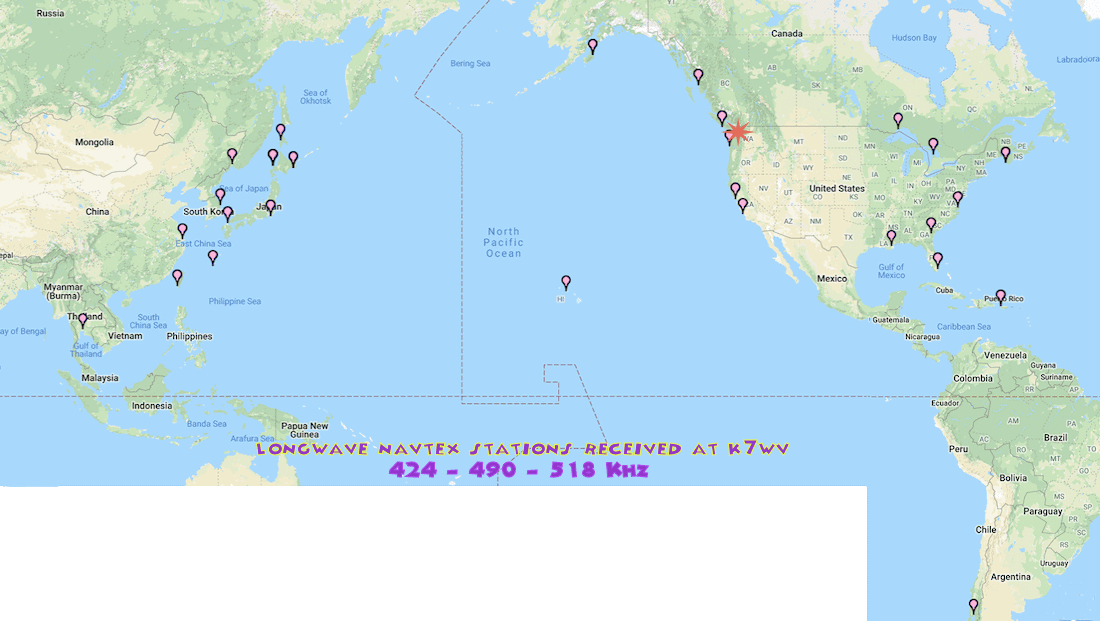
ALASKA
VISITS AND
NDB
PERSEUS RECORDINGS: 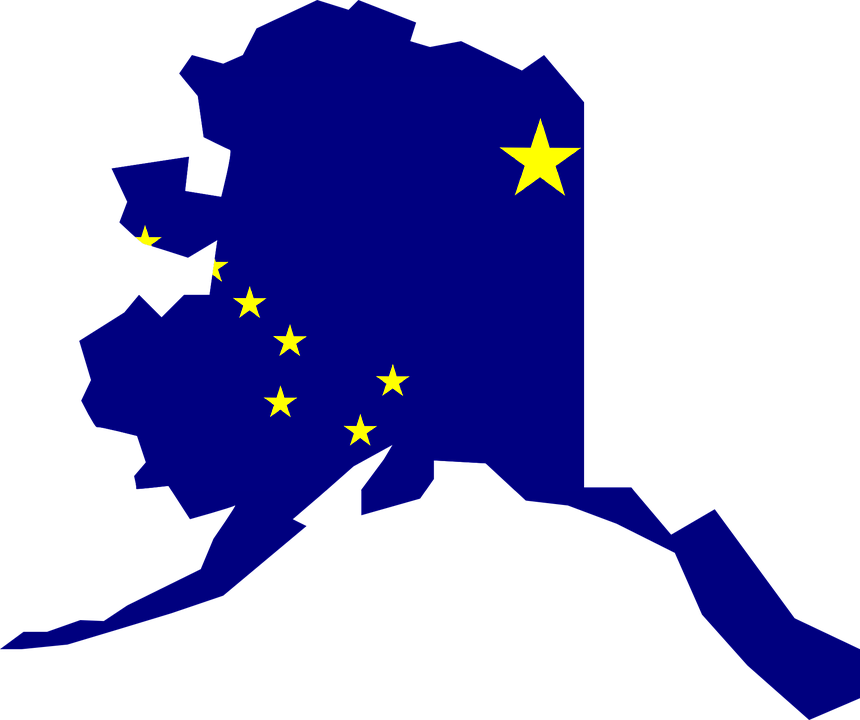
Aug 02 2013: While visiting Anchorage, AK on primarily a geocaching and sightseeing trip, I deployed the portable Perseus setup and ALA-100M at 1:00-2:30 AM local time and got some decent wideband recordings of the MW and LW bands using two directional loops. 2013 Alaska Beaconlog: It was twilight in the northern sky all night which limited reception of far northern Alaska (in 24 hour daylight) but I ID'd 52 distinct AK NDBs from 200-529 KHz. This data along with observed offsets was sent up to RNA for help in determining just what is still active up there and to increase the chances of AK beacon hunters this DX season. This beacon log is HERE. I missed some known active stations in the far NW of the state due to loop orientation and daylight paths. Others I heard that had never been reported such as OYN and PPC seemed exceedingly weak and unlikely to ever be heard outside AK. 20 TWEB voice aviation weather broadcasts were noted on the indicated beacons and were relaying the indicated originating station as listed on this site. Two beacons were OTS during the session by NOTAM (not counting ADK which never returned to service).
Aug 05 2014: Again visiting Anchorage, AK on vacation, I made some Perseus recordings from the exact same location as last year at almost exactly the same of year using four loop orientations of the Wellbrook ALA-100M from 0950-1220 UTC. Due to the installation of high intensity security lighting in the set up location it was much noisier this time and is no longer a great spot for clean reception. K-Index was 2 (Boulder) which is the same as last year. This time 52 AK beacons were heard. Two heard last time were OTS by NOTAM (VIR 281 and PPC 340), and 2 stations heard last time were not heard this time (GBH 417 because it is so exceedingly weak and the noise floor was raised, and AMF 403 for unknown reasons). However 4 new stations NOT heard last year were in this time with very good signals (OAY 263, BVK 325, AKW 229 and AFE 223). Overall the same numbers as last year's session. Notable also was the rare Yukon beacon YOC 284 in nicely; it was missing from all recordings last year. Results are HERE: 2014 AK Beacons from Anchorage. 19 TWEB broadcasts were heard this session. One very nearby beacon not heard either time, UMM 326, is decommisioned by NOTAM. OAY and BVK may be the ones to watch for this Fall 2014 season. OAY in particular was very robust given the distance. Medium wave was less affected by the noise and was full of loud Hawaiians, NHK and commercial Japanese (with lots of play-by-play baseball up and down the dial) and a few Koreans as well.
Jul 21 2018: Again visiting Anchorage, AK on vacation for some geocaching and sightseeing in various Kenai Peninsula cities, I took the time to make a recording overnight at the same location near the airport. On the downside: It never got dark! This was 21 July. Too light out to see stars. Bad K-Index of 3. And bad QRM which has gotten terrible at this location. Finally, lots of beacons out of service via NOTAM (and one decommisioned: CMQ 338). But I did get 41 signals worth mentioning. It is HERE: 2018 AK Beacons from Anchorage. I also visited and photographed OLT, ACE and IWW in person, each very different designs. I sent numerous pics of these up to NDBlist photos on Groups IO along with the log. 12 TWEB broadcasts were heard so that cool feature of Alaskan NDBs is still around.
May 27 2021: I've returned from a 4-day visit to the Anchorage, AK area. Fantastic weather, visibility and highs to 71° F or 22° C (!) were most welcome. On May 25 I drove to Talkeetna and did locate and photograph LW aero beacon 305 PEE. Not easy to get to and no Verizon internet in Talkeetna to get exact coordinates. But we did have success and observed (and photographed) this most unusual setup close up. Pics posted to NDBlist photos section. This beacon does not get out well at all and consists of a single pole (which doesn't even clear the trees) with a tiny capacitive hat on top. Looks like cables have been wrapped/draped around the pole in a makeshift manner in several places to try to increase capacitive efficiency. This has been a very difficult beacon to log here in WA and has required a most exceptional night to be heard at the home QTH. Also heard a few times on KIWI SDRs at Grayland, WA and Masset, BC. Just a day or two prior to my visit the offsets were drastically changed to -404/+404. This change seems to have made it a more robust and frequently heard beacon using the Masset BC Kiwi since returning from the visit. Update note: PEE comes in better with the offset change and has beem heard many times here this past season (home QTH) as well as at Oregon's Rockwork DXpedition and Washington's Grayland DXpedition. Still it is not easy or common.
On May 27 I made some Perseus recordings from Anchorage around 2:30 AM local time. Light outside all night, no stars. Instead of buzzing power line noise there was hissing white noise from light poles spoiling things so the recording session was brief. The recordings obtained were very poor due to noise and condx with only 22 AK beacons identified, plus a Canadian Coast Guard vessel that often visits Alaskan waters. Results HERE. 411 ILI and 346 OLT were both out of service by NOTAM. There is a Letter To Airmen LTA-OSGW-93 proposing OLT be decommissioned so it will probably never be active again. All TWEB service was discontinued throughout Alaska on Jan 01, 2020.
The dedicated portable equipment set aside for airline travel worked fine so maybe we will have better luck and conditions on future trips.
UPDATE!
Aug 27 2022: I
finally obtained wonderfully clear noise-free recordings from
practically the exact
same spot
as most of these previous visits during this year's visit to Anchorage.
Heard was what I believe to be every NDB
still transmitting from the
state of Alaska which was sadly only 44
stations (VTR 350 soon returned to the air although absent here). A few
like SPY and TOG were
off by NOTAM and may return but most of the other missing beacons will
never be back.
There are still some tough and challenging catches to be
had but for me nothing
unheard at my home QTH remains. View the log HERE:
2022
AK Beacons from Anchorage,
audio clips and reception map included.
HF
BEACONS:
These
are Amateur (Ham) Beacons owned by licensed
operators to gauge propagation conditions on 10 Meters. There are about
300
operating in the world at any given time. Most of these run 1 to 5
watts
into a vertical antenna. They use autokeyers to ID in CW, from 28100 -
28300
Khz. They are in various degrees of health, with some very bad
artifacts notable on many. At the height of the sunspot cycle one can
hear nearly all of them worldwide. 2W beacons from Greece, Russian
beacons
over the pole, even Antarctica's only beacon and all Australian states
(and beacons) have all been heard here.
A rotatable gain antenna is a big help
with these. I use a homebrew
2-element monoband yagi with a DX Engineering RPA-1 preamp.
Nov 27 2013: NDBList's
Coordinated
Listening Event (CLE) #176 introduced me to DXing these 10M HAM
propagation
beacons. 70 beacons were heard here over the weekend using Perseus and
the
Wellbrook ALA-100M, same Wellbrook antenna used for LW DX.
Jan 27 2014: The RYO 10-meter 2-element Monobander of AA1DO's design (see April 1999 QST for build instructions) is re-deployed and back in operation after being completely destroyed by a tree fall in 2009. Testing on 28 MHz low power propagation beacon reception with Perseus has been highly successful with over 370 heard in 42 countries and 45 US states. ALL seven continents heard (to include Antactica's only beacon VP8ADE, and all 7 Australian states). Here is my K7WV 10-Meter Ham Beacon Log. These beacons typically run a few watts into a vertical antenna and are reportable to NDBList and the RNA database. I have been the first or only reporter of a number of the North American ones. The antenna appears to function as before with excellent directionality and forward gain.
July 1 2014: The new M2 6M3 is now on the same mast as the homebrew 10M yagi and turned by the same rotor. See it HERE. As of July 2014 These 50 MHz Beacons have been heard on 6 meters (new antenna operational on July 1). These are also reportable to RNA.
Nov 1 2017: The rotor motor failed after 19 years; Replaced with identical unit CM 45-12931. Picture of new rotor motor is HERE and it is fully compatible with original indoor azimuth selector. Build quality of the new motor seems a bit questionable. (Note: unit still working perfectly 7 years later. CM no longer selling this product so this option is no longer available)
Feb 8 2023:
The amateur
beacons are back
with the rise in solar activity and world wide F2 skip. With horrible
noise now present on LW at the home QTH
I'll be getting back into the 10M game out of necessity for the time
being.
UPDATE! Feb 24
2024:
Problem: the 2-element monobander was underperforming the Wellbrook
loops at 28 Mhz so something was wrong. Rooftop maintenance included
de-oxidizing and
replacing parts. The RESTORED ANTENNA
captured 25 European beacons this
morning on 10 meters! A dozen had never been heard here before.
Mar 07 2024: Turning
the beam to 260° this
afternoon brought in 5 AUS and 3 NZL HAM beacons. 2 AUS and 1 NZL were
new loggings at this QTH. See K7WV 10-Meter Ham
Beacon Log
for received beacon list.
Oct 25 2024: 30
European beacons identified under very fine conditions, 6 new. Also
some (but not all available) ZS, ZL and VK beacons. 10M remains hot. November 2024 update:
I have received ALL VK and ZL beacons in current operation. VK3RMH was
tough, mine is the only heard log in North America of this Melbourne
beacon.
Best worldwide shortwave amateur beacon resource, updated daily: Shortwave Amateur Beacons
FM DXing:
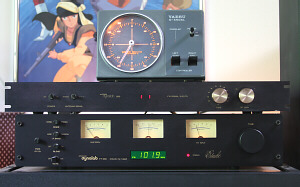
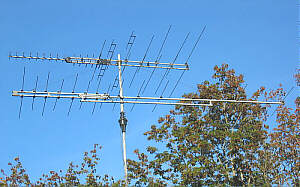
Etude and Signal Sleuth receiving
KINK Portland
APS-14 below CM
Quantum 1162A TV
antenna
Equipment
used at K7WV for broadcast FM DX
reception:
Antenna
Performance Specialties
APS-14 (208" boom length, 14 element). No longer
available; my FM
DX "secret weapon"
Magnum
Dynalab
FT101A "Etude" tuner (features manual weighted tuning knob
for precise
tuning)
Magnum
Dynalab
205 "Signal Sleuth" tunable RF Preamp (Up to 30 db added gain)
Carver
TX-11a FM Tuner
Sony ST-10F Japanese-frequency
AM/FM
stereo tuner (76-90
Mhz) Obtained in Japan for use there; tuned in my favorite
station FM Gunma / エフエム群馬
and so many others.
Sony
XDR-F1HD AM/FM Tuner with RDS and 'HD Radio' decoding.
Spectacular FM
performer
FM+
Downconverter for
Perseus (SN#00032) SDR for FM band, lacks 'HD Radio',
features user variable
bandwidth.
Blonder
Tongue MWT-2B Tunable Notch Trap Useful in eliminating
adjacent channel splatter
Yaesu G-450XL rotor (to turn
the APS-14) This has been replaced by the G-450A, virtually identical.
Yaesu G-450A upgrades and repairs
I have never had to repair mine in 19 years, but the upgrades are
interesting. Just purchased a second unit.
55' (17 m) RG-6 quad-shielded cable
(choked at APS-14
feedpoint with numerous ferrite beads; APS-14 is 75-ohm)
63' (19 m) Times Microwave LMR-400-75
RG-11 run from
stereo rack to ham shack (APS-14 feed for the FM+)
Radio Shack 6-element
FM-only yagi antenna
(discontinued) for remote FM campsite ops
Grundig
G8 ULR with excellent FM receiver for travel use
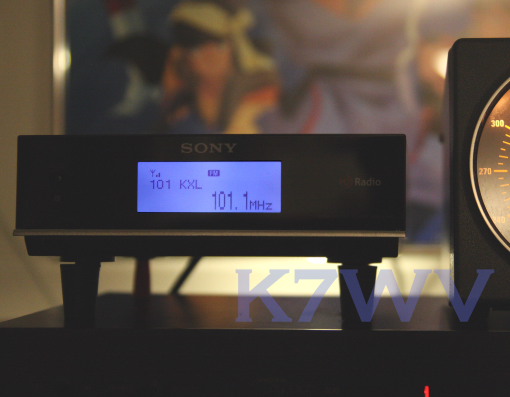
The mast for the receiving antennas is 1.5-inch EMT conduit mounted at
the
roof apex and rotated with a Yaesu G-450 ham radio rotor. I have both
the
APS-14
and a Channel Master Quantum 1162A (with pre-amp module) TV antenna
secured
to it. The TV antenna (with amplifier module) did a decent job bringing
in
analog Canadian TV (before going digital in 2011). These days it
is providing surprisingly decent service by pulling in 55 digital channels
from the south to include the new 1-KW KBTC Seattle repeater on digital
channel 28 (NHK
World over the air at last!). The
dual antenna installation has
survived windstorms with 70 mph gusts (and the magnitude 6.8
Nisqually
Earthquake). This year marks 20 years of flawless operation.
The
MD Etude had been my primary FM tuner since
acquiring it, due to its high build quality, switchable filters, and a
manual
knob tuning, an advantage for DXing in a large metro area with a
crowded
dial. The new Sony XDR-F1HD out-DX's it but the audio quality of the
stock
unit falls short. The Sony can be modded for "audiophile grade" audio
but the guy who was doing the mods has recently ceased doing
them.
There is
a cheap and easy fix for the bad sounding rolloff that involves adding
a
couple caps which I may do instead. I now posess an FM+
downconverter
for Perseus which is really more fun and sounds better than the
XDR-F1HD, with
similar
DX performance. PI RDS readouts too.
DX performance of the APS-14
computer-optimized
75-ohm 14-element 208" antenna is almost magical. 116 FM stations and
13
translators are often receivable here despite a valley location with
nearby
hills and mountains in all directions. These include all
Vancouver BC
stations, 18 (of 22) from Portland OR, all Victoria BC and even 2 from
Spokane
(across the Cascades). During
tropo enhancement,
8 stations can be heard from Eugene-Springfield OR. This does not
include
sporadic E openings of course. My
Radio Shack 6-element
FM antenna, by comparison, was only capable of bringing in 66 stations
in
1997 (but numerous new stations in the coverage area have signed on
since
then). There was nothing comparable at the time for FM DX
(later version,
the 200" APS-13,
was almost identical; reportedly a cheaper, more flimsy build but with
a
better average F/B ratio of 30db; unfortunately both of these fine
antennas
are long discontinued). In 2011 DXers had a Swedish-made alternative in
the
Körner
19.3
and smaller 15.12
(made by VHF Teknik). You guessed it, they are no longer made. Today's
FM
DXers will probably have to settle for the 138"
CM 3025
Stereo probe 9,
also discontinued but probably obtainable on auction sites as so many
were
made. After 20+ years installed, the APS-14 here at K7WV just keeps
putting
out. Sadly, it is irreplaceable unless one undertakes the project of
building
the Körner
19.3 (I am considering it, the
performance is that much better
than my APS-14 that it would actually be an upgrade).
UPDATE: Good news! As
of May 2012 a new player has arisen
in InnovAntennas of the UK. They ship to the US and offer a
14-element
model! Better order one while you can! Performance specs are
similar
to my APS-14 and the build quality is considerably higher. For the
ultimate in FM DX specialization they now offer 17 and 18 element models! These offerings
have me seriously thinking about replacing the APS-14!
Sep 2022 UPDATE: A new tool for FM co-channel cancellation is available in the latest SDR# software for Airspy Discovery and related SDRs. Video demo HERE.
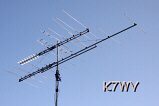 |
Early in 2004
a half-dozen Seattle FM stations
began broadcasting in
IBOC.
This digital + analog scheme now known as "HD Radio" (for Hybrid
Digital,
NOT
High Def) has spread like the plague and has been extremely destructive
of
the adjacent channels, completely wiping out stations such as CHQM
103.5
which were full quieting in stereo prior to the onslaught. The FCC
political
leadership is heavily invested in Ibiquity, the HD monopoly,
so they
will continue to support massive intentional interference on both AM
and
FM. The scourge has grown to afflict so many more local stations that
available
FM DX channels have been reduced to a handful. Subsequently I no longer
devote
much time to serious FM Dxing. I still enjoy using my equipment to
listen
to distant markets though, and have acquired a
Sony
XDR-F1HD
to compare its breakthrough
80db adjacent channel
selectivity, RDS and even to try its HD Radio decode capability with
the
mighty APS-14 antenna. It performs as the reviews stated, making it a
"reference"
by which all other tuners must be compared (and will fall short of in
performance). Truly amazing to receive distant stations in stereo at
full
quieting at all times (there appears to be no
"stereo
penalty" or
DX hiss with the Sony on Analog or Digital). Sony discontinued the
XDR-F1HD
in early 2011 and says it will make no further HD Radio products. There
is
hope for a restored FM band as the HD Radio business model is failing
and
no other country (not even Canada) has adopted it. 2016
Update:
Looks like it is here to stay, for better or worse. Northern Mexico
and Canada are now using it. I acquired an exceedingly
rare and sought-after Clarion Subaru OEM CP635U1
HD
Radio head unit for my 2010 Subaru
Forester in 2014 and I
must confess to
enjoying HD radio on the road, sounds much better than FM or Satellite
but has limited range.
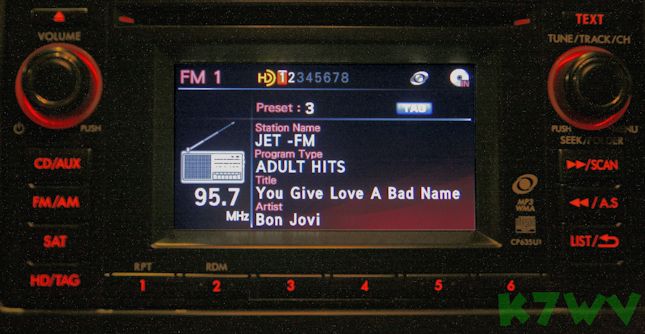
I now have a new add-on for Perseus SDR owners: The Microtelecom FM+ downconverter (which is NOT sold in the US and now discontinued). Some observations and comparisons with Sony XDR-F1HD follow. RDS codes: PI, PS, PTY (European RDS, not North American RBDS decodes, so a rock station sending PTY code 5 will read EDUCATION instead of ROCK) while the XDR-F1HD provides PS and RT; Ability to record 2 Mhz chunks of spectrum at a time directly to hard drive. DX performance as good as the XDR-F1HD, except it can't come close to the Sony's stereo quieting on weak signals. (New Studio 1 software improves FM stereo quieting to XDR-F1HD levels and provides PI, PS and RT RDS decodes.) No "HD Radio" decoding with this European-made unit. It offers user-variable custom bandwidth, a powerful tool not available on the Sony. It sounds way better than the somewhat fatiguing sound of the stock XDR-F1HD with a decent computer sound card. It doesn't get hot when operating like the Sony. Operable on 12 VDC for field use. Switchable deemphasis for Europe or North America. Vastly superior signal strength display and readability than the small Sony display. Can experience overload with the APS-14 pointing directly toward Seattle while the XDR-F1HD does not.
Overall I find the FM+ a lot more fun to use. I'm now using Studio1 software to enhance it even further. The XDR-F1HD is in the stereo component rack upstairs while the FM+ is in the downstairs ham shack. Each unit is connectible to the APS-14 using RG11 runs to a wall plate. Different "missions" mean both units get semi-regular use. Both units have been discontinued.
CKPK Vancouver w/ RDS on XDR-F1HD
KWJJ Portland w/ RDS on FM+ and Perseus
CHHR Vancouver w/ RDS using Studio1
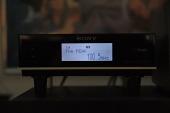
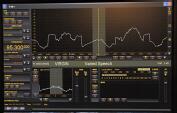
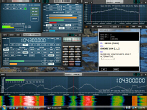
LINKS TO RELATED SITES:
---Amateur
Radio---
| Amateur Radio Resources |
K7WV
(My original radio page, mostly mirrors this one with fewer pics)
QSL.NET (Licensed
Ham? You can get free
space for a web page like this one!)
ARRL Homepage
(Latest news and links for
U.S. hams)
RAC
Radio Amateurs of Canada
(Canadian callsign directory, many links)
JARL
English Website
(Japan Amateur Radio League)
QRZ
Callsign Database
(Callsign directory, ham web pages, QSL pics)
Buckmaster
HamCall
(Callsign Lookup, over 1.5 million US & DX
calls)
WM7D
Callsign Database
(US / Canada, updated daily)
UALR
Callsign Lookup
(US only,updated daily from FCC files)
10-10 International (Organization
for users of the 10-meter ham band)
10-10
Number Search
(Enter 10-10# or callsign)
10 Meter Amateur Beacons 10 Meter
Amateur Beacon Database, kept up to date
Last
25 HF DX
Spots (Real-time
DX spots)
Log Searches
(Find out if
you're in the DX log)
eHAM.net (News,
equipment reviews, forums,
articles)
DX Summit
(Search old spots for posted
QSL info)
KA9FOX's Ham Radio
Contesting and
DXing (great HF contesting info)
K4UTE
quick
QSL Manager lookup
(with QSL mgr's complete address)
KL7J
Amateur Radio Page
(Alaskan Radio/Propagation Info)
AC6V's Amateur Radio
& DX Reference
(Detailed info on all aspects of ham radio)
Geratol Net (80-meter
Extra class
sub-band WAS group offers nice award)
QSO/SWL
Real-time Maps from latest spots, separate maps for 28 Mhz
and up, including
FM DX.
10
Meter Beacon List (WJ5O) comprehensive 10M amateur beacon
listing
Shortwave Amateur
Beacon List (All Bands including complete up-to-date 10 Meter List)
NCDXF
Beacons - (Frequencies, Status, Schedule)
Solar
Cycle
Progression
(Latest NOAA/SEC charts of Cycle 25)
Make More
Miles on VHF
(Meteorscatter & aurora links for VHF radio amateurs)
W8WN HSMS
Nomepage (FSK441
Meteor Scatter, JT44 EME w/ free software)
NOAA
Real-Time Auroral
Oval Auroral Oval and CMEs in real time, Northern hemisphere
(Southern hemisphere
available)
International
Space Station Visual Sighting (ISS sighting
opportunities)
N2YO
Amateur Satellite
tracking and info (select ham satellite and track)
OMISS (Runs WAS
nets on several bands
for those working on award)
HHH Net (A
late-night 40-meter WAS net,
0700z on 7.235)
3905 Century Club
(CW, RTTY, PSK31,
SSB WAS nets on several bands)
---Broadcast
and Beacon DXing---
| My Logs: Home QTH and DXpeditions |
| My Grayland DXpedition Log I (Oct 20, 2007) using highly modified R71A, my first experience with Beverage antennas |
| My Grayland DXpedition Log II (Oct 4, 2008) using Perseus: 24 Alaskans w/ IDs, 1 KW JA's, DZRH Manila |
| My Grayland DXpedition Log III (Oct 23, 2010) AK/HI 29 Alaskans ID'd incl Fairbanks area stations. Asia mediocre |
| My Grayland DXpedition Log IV (Oct 8, 2011) Not incl Asian 'big guns' 22 Alaskans, AFN Misawa 1575, R. Radonezh |
| My Grayland DXpedition Log V (Oct 6, 2012) 16 Alaskans incl KOAN, loud comm'l JA's |
| My Grayland DXpedition Log VI (Oct 19, 2013) Laos, Myanmar, China incl Tibetan Lang., at least 15 Alaskans |
| My Grayland DXpedition Log VII (Oct 18, 2014) AFN Misawa 1575, Filipinos, loud JAs and Koreans (N&S), MBC 1017, 12 Alaskans |
| My Grayland DXpedition Log VIII (Oct 10 2015) DKAZ used in lieu of Beverage; MW: AFN 1575, 40+ Aus/NZ, KGUM Guam 567, 20 Hawaiians |
| My Grayland DXpedition Log IX (Oct 15-16 2016) Using DKAZ for MW and a Delta loop / ALA100M for LW. MW: 65+ Aus/NZ, 21 Philippines 22 Hawaiians |
| My Grayland DXpedition Log X (Oct 13-15 2018) 160-ft DKAZ for MW Kiribati 1440, Gold FM 990 Fiji, AFN Misawa 1575, 53 JAs. 17 Alaskans, 16 Hawaiians |
| My Grayland DXpedition (IRCA) Log (Sep 09-10 2019) 160-ft DKAZ, 10 x 20ft flag for LW. Record 16 AUS NDBs. MW: 85 AUS & 41 NZ, 14 Alaskans, 19 Hawaiian |
| My Grayland DXpedition Oct 2020 Log (Oct 27-29 2020) 160 ft DKAZ at 270°. A couple dozen NDBs including 4 RSE, 2 AUS; MW: 83 Japanese; 23 Alaskans, 11 HWA |
| My Grayland DXpedition Oct 2021 Log (Sep 29-Oct 01 2021) 160 ft DKAZ at 270° few NDBs, MW: 6 Vietnam, 11 Taiwan, 79 Japan, 8 Philippines. 20 Alaskans 15 HWA |
| My Grayland DXpedition Oct 2022 Log: (Oct 11-13 2022) 160 ft DKAZ at 290° 35 Alaskan NDBs, 4 Russians MW: 100+ Japan incl 3 MARTIS, 30 Alaskans 13 HWA |
| My Casa Sea Esta DXpedition JUN 2023 Log: (Jun 27-30 2023) Wellbrook Phased Array at 270°, 31 Alaska & Pacific NDBs, MW 70 NZ, 45 Aus, 11 Alaskans, 18 HWA |
| My Casa Sea Esta DXpedition Oct 2023 Log (Oct 18-20 2023) DKAZ at 255°, NDB results: 33 Alaskan NDBs, 3 RSE, 14 Pacific MW 46 Japan. 25 Alaskans 17 HWA |
| My Casa Sea Esta DXpedition JUL 2024 Log (Jul 30-Aug 01 2024) DKAZ at 275°, NDB results: 20 Alaskan NDBs, 1 NZL MW 57 AUS 37 NZL. 10 Alaskans only 8 HWA |
|
|
| My Rockwork 4 2015 DXpedition I Page (Jun 27-28 2015) 20 Pacific/DU NDBs using small 13' per side delta loop, MW: 53 New Zealand on Jun 28 |
| My Rockwork 4 2015 DXpedition II page (Aug 07-09 2015) 25 Pacific/DU NDBs. MW:16 Hawaiians, 58 NZ and 29 Australians (87 DUs) |
| My Rockwork 4 2016 International DXpedition Page (July 09-11 2016) Subdued July conditions yielded: Pac/DU NDBs 06. MW: 41 NZ, 14 Aus, 14 Hawaiians. |
| My Rockwork 4 2017 DXpedition Page (Aug 02-07 2017) 39 Pacific/DU NDBs. MW: 16 HI, 72 NZ, 41 Australians (113 DUs). |
| My Rockwork 4 2018 DXpedition Page (Aug 04-08 2018) 56 Pacific/DU NDBs. MW: 64 NZ, 45 Australians (109 DUs) and 17 HI |
| My Rockwork 4 2019 DXpedition Page (Aug 04-08 2019) 73 Pac/DU NDBs: 14 N.A. firsts incl NDBs from TAZ and NZ's South Isl. MW: (101 DUs) 16 HI, 65 NZ, 36 AUS |
| My Rockwork 4 2020 DXpedition Page (Aug 07-10 2020) 63 Pac/DU NDBs covering 4 AUS states. MW results: excellent! 18 HI, 74 NZ, 53 Aus (127 DUs), All AUS states. |
| My Rockwork 4 2021 DXpedition Page (Aug 03-06 2021) 86 Pac/DU NDBs (new record with 35 AUS beacons) MW: 17 HI, 83 NZ, 74 AUS (157 DUs), All AUS states |
| My Rockwork 2 2021 DXpedition II Pg (Oct 14-16 2021) 57 Pac/DU NDBs incl 26 AUS. 38 Alaskan NDBs and 2 RSE. MW: I/W; a vigorous mix of DU and Asia |
| My Rockwork 4 2022 DXpedition Page (Aug 04-06 2022) 40 Pac/DU NDBs MW: 82 NZ, only 26 Australians (107 DUs) and only 12 HI, Hugely NZL-centric! |
| My Rockwork 4 2023 DXpedition Page (Aug 01-04 2023) 28 Pac/DU NDBs MW: 40 NZ, 32 AUS, 14 HI; 10 KW from W. Aus with 6PNN 1152. Only 73 DUs. |
| My Rockwork 4 2024 Ocean Cliff Page (Aug 06-07 2024) 33 Pac/DU NDBs MW: 68 NZ, 20 AUS, 11 HI. New stns from both AUS and NZL. 88 DUs. |
|
|
| My BCB Log MW Reception loggings from my home QTH |
| My MW 'Graveyards" log 84 stations logged from home QTH on the six 'Graveyard' low-power BCB channels |
| My TIS/HAR 26 stations received from the home QTH. |
| My Longwave NDB Beacon Log Over 660 Aeronautical and Amateur Longwave Beacons received at K7WV home QTH 2001-Present |
| NDB Beacon Log Over 100 Daytime NDBs (within 2 hrs of local noon) received at home QTH |
| NDB Beacon Log 460+ received from Albuquerque, NM past 4 years during end-of-year visits (Perseus / ALA-100M) |
| NDB Beacon Log received from Litchfield, MN with noisy inverter Aug 07, 2010 (Perseus / ALA-100M) |
| Alaska NDB Log 2013 K7WV's AK beacons received from Anchorage, AK on Aug 02 ,2013 (Perseus / ALA-100M) |
| Alaska NDB Log 2014 K7WV's AK beacons from an Aug 05, 2014 Perseus session from Anchorage, AK. Latest offsets. |
| Alaska NDB Log 2018 K7WV's AK beacons from the same Anchorage, AK location as above two logs, but conditions were not so good, and many out of service |
| Alaska NDB Log 2021 K7WV's AK beacons from same ANC location as above. Condx dreadful with twilight sky and no real night. But we did get something. May 27, 2021 |
| Alaska NDB Log 2022 K7WV's AK beacons from the same Anchorage, AK location as above logs, Actually got fully dark in late Aug with clear and noise-free recordings. |
| My DGPS stations decoded (64 stations) using Perseus and Spectrum Lab (& ADGPS) software with two opposed broadband loops. DGPS Service is now all but gone. |
| My NAVTEX stations decoded using Perseus with YaND. 424 Khz Japan stations (2014), China, Taiwan, Thailand on 518, 490 station (2018), Chile station (2019) |
| 28 MHz Amateur Beacons 370 received from 45 US states and 42 countries, All 7 Continents. All 2014 and on logs utilizing the restored, rotatable 2-EL 10M Monobander |
| 50 MHz Amateur Beacons 22 received in the season following the 6-meter antenna restoration on 30 June 2014. / 6-meters restored following repair 18 Oct 2024 / |
| RNA online interactive log Show: All Results, Heard By: Tom R, Brier WA K7WV or all users, view results or create maps. Select NDB/HAM/DGPS/NAVTEX, one or all. |
| MW and LW |
IRCA
I have been a member off and on over the years. Now a renewed member. I
was a presenter on the Rockwork DXpeditions at
the IRCA
convention in September, 2019.
IRCA Group
Very active discussion group with daily MW DX reports, equipment,
DXpeditions and more.
NDBlist
Group Very active beacon enthusiasts, member loggings
comprise RNA/RWW,
most comprehensive and up-to
date lists of NDBs worldwide
National Radio
Club (MW DXing info, DX Audio Service) The "other" BCB DX
club (I am in the IRCA)
DXing
the Graveyard Channels Tips and techniques of successful GY
DXing (NRC
article)
Graveyard
DX Info and
resources for the GY enthusiast
AM
Expanded
Band (Latest list of AM stations 1600-1700 Khz)
1601-1701
Khz stations--Asia / Australia
List of
expanded Band AM stations known to
be operating in Asia / Australia
Asian
X-Band (1600-1701 Khz)
Low Frequency Amateur Beacons
Currently on the air, updated by LWCA.
Rockwork
4 DXpedition 2013 Report Gary DeBock with tricked out PL-380
and 12"
FSL
Listening
For LowFERs (Large LW loop antenna construction ideas,
pre-SDR old
school techniques)
Listening
for LowFERs
II (Part II of above)
| Wellbrook Phased Array Extensive 2008 review by the late John Bryant. Used at our June 2023 DXpedition to Grayland |
| Loop Antennas at G4CNN Loop antenna farm in the UK |
| Loop Calculator (Input size and number turns, get tuning range) |
| Wideband Magnetic Loop for SDRs (Construction, calculations, and performance) |
| DKAZ Antenna Cookbook: powerful directional antenna for MW DX use, a DXpedition favorite |
| Vactrols for the MW / LW DXer More info on Colin's vactrols; I have one of his assembled units, works well in certain situations |
| Broadband Common Mode Chokes: Theory and building guide |
| Longwave Homepage (From LWCA. Info and happenings below 530 Khz) |
| ARGO for viewing QRSS modes. Popular automated amateur beacon mode on Longwave |
| WSJT Home Page From K1JT: download WSPR and WSJT-X digital software here. Digital modes for meteor scatter, beacons, 6M |
| WSPR: an introduction YouTube video for Weak Signal Propagation Reporter WSPR is favored for LW, some 10 Meter beacons |
| DX Zone: Longwave VLF links |
| Navtex Transmissions (424, 486, 490, 518 Khz Navtex broadcasts and times) |
| HF Radio-Telex Transmissions (SITOR-B broadcasts can be received using any of the popular Navtex decoders) |
| Negative Keying Tool: Negative keying is an anomaly that sometimes occurs with NDBs. Transpose negative keying to valid ID |
| HF Underground boards All aspects of HF including beacons; logs and discussions |
| NDB Photo Gallery has pics of numerous US and Canadian NDBs with a variety of antenna types (a bit dated with many decoms) |
| W3EEE Low Freq Radio Page Using SDRs at LF, NDB photos |
| 26 Mhz Driftnet Beacons extensive list of known Driftnet buoy calls and freq's 26-27 Mhz |
| Driftnet Beacon DXing ID small buoy beacons in the 1700 Khz MW region attached to fishing nets at sea |
| Unlicenced "Part 15" AM radio includes station Listing of legal unlicensed 100 milliwatt AM broadcast stations on the air in the USA |
| Longwave DGPS Beacons DGPS beacons believed to still be active. Decomissioned in North America and Australia. |
| LW Transcribed Weather Broadcasts TWEB broadcasts in Alaska permanently shut down 01/01/2020. |
| Use your computer to Ambush Unsuspecting NDBs (Using Spectran for NDB work) |
| PA0LQ Narrow Audio Filter for NDB work |
| Low Pwr AM information stations in the US and territories |
| TIS/HAR List by the IRCA. Most comprehensive and precise listing of TIS/HAR stations in the US. |
| FSL Antenna User's Guide by Gary DeBock |
| Perseus V5 software Now with highly detailed waterfall and spectrum displays, scalable GUI and more. I prefer it to Studio One. |
| HDSDR Free software for use with SDR (including Perseus), four notch filters and other useful features |
| Studio 1 receiving software for Perseus and most other SDRs. Works with FM+ downconverter too. Bought out by SDRplay. |
| Online SDRs for Public Use |
Univ. of Twente
WebSDR, Enschede, Netherlands; Tune a real-time SDR in
Europe! Available 24/7 and accepts multiple users. Sensitive antenna.
KiwiSDR:
Kiwi SDRs for public use. Up to 4 simultaneous users. Occasionally set
up at DXpeditions on a temporary basis.
WebSDR
Other SDR tuners
available for use over the Web.
Perseus SDR Server Map Users make
their Perseus units available for worldwide free use online through
this utility (dated and abandoned by creators, still works)
Navaid Database
(Identify that NDB/low frequency beacon!)
NAVTEX
world wide
messages captured from receivers worldwide using the Frisnit
decoder;
compare your decoded msgs
VE7SL (Steve)
Radio Blog (Active NDBlist reporter and beacon experimenter,
CW
enthusiast from LW to light)
Counting
Radios Kit building, antennas and radio-related blog
(including building the PA0RDT Miniwhip kits available on Ebay)
Shortwave Central
Happenings on the SWL frequencies, tropical bands, etc
Negative Keying Tool:
Negative keying is an anomaly that occurs from time to time with NDBs.
Transpose negative keying to a useful ID.
DX
Fishbarrel TP MWDX spotting tool from Victoria, BC
(Nick
Hall-Patch). Nick will also set up this feature at DXpeditions that he
attends.
Masset BC DX
Fishbarrel See conditions live from Haida Gwaii
where a KIWI SDR is available for world-class LW/MW DX usage
Totsuka DXer's
Circle downloadable PROPAGATION journals. This Yokohama based
club publishes an annual journal of their activities. Some of their
members have DXed with us!
| other West Coast MW DXpeditions |
Master Index Page for all of Bill's DXpeditions 2010-2024
Grayland (Casa
Sea-Esta) Sep 08-17, 2022 Bill heard a couple of
gems here, 1584 T8AA Palau and my favorite: MW beacon 907 UB from
Russia!
Grayland (Casa
Sea-Esta) Feb 21-Mar 3 2022 Great Alaskans here, including
Fairbanks and Kotzebue
Grayland
(Casa Sea-Esta) Sep 18-25, 2021 Our crew of 4 arrived at CSE
just 3 days later with almost the same conditions incl. mediocre Kp but
good Vietnam. Our
Results
Grayland
(Casa Sea-Esta) Feb 22-28, 2021 Bill's results here. 160-foot
DKAZ at 305°.
Grayland (Casa
Sea-Esta) Sep 15-20 2020 Bill had a KiwiSDR set up and I
spent many hours being blown away by the awesome Alaskans!
Great fun! Kp
Index of zero, KBRW, KOTZ
in loud and alone.
Grayland (Casa
Sea-Esta) Feb 17-22 2020 Nice haul of Alaskans including KBRW
by Bill W. DKAZ at 290°
Masset, BC DXpedition 2020 Dec 26 - Jan 03,
2020
More DX gems from Haida Gwaii (Formerly the Queen Charlotte
Islands). Strong possibility of a remote KiwiSDR being activated
full-time in
2020!
Grayland
(Casa
Sea-Esta) Sep 08-11 2019 From Bill Whitacre. I
also attended this large DXpedition for 2 nights, 800 feet away at
Breakwater Inn. My
DXpedition web
page
Grayland (Casa Sea-Esta) Feb 18-23 2019
160-foot DKAZ at 287° (more
northerly orientation than we used in October)
Masset,
BC DXpedition Dec-Jan 2019 (link to pdf file)
Grayland (Casa Sea-Esta) and Sans Souci (OR)
Aug 06-12 2018 from Bill Whitacre with the usual
160' DKAZ. I was on the Manzanita cliffs then so interesting to compare.
Grayland (Casa Sea-Esta) Feb 18-25 2018
from Bill Whitacre, using a 160' DKAZ and 1000-foot BOG(s): MW DX logs
(Nice Alaskans, including Fairbanks 970)
Grayland and Sans Souci MW logs Aug 8-13
2017 from Bill Whitacre, again using a 160-foot DKAZ from two
locations.
Grayland logs and audio clips from Bill
Whitacre Feb 2017, last DXpedition ever (?) at
the apparently closed Grayland
Motel and Cottages. DKAZ aimed at 290/300°, 26 AK's
Grayland and Sans Souci MW logs Jul 25-Aug 1
2016 from Bill Whitacre using a 160-foot DKAZ.
Grayland
logs from
Bill Whitacre Feb 2016 using a DKAZ and Perseus. More Asians
in than
his previous logs as you would expect in Feb
Grayland
& Sans
Souci MW logs July 2015 with audio July 2015 Bill Whitacre's
results
using the 160-foot terminated DKAZ antenna
Grayland
logs from
Bill Whitacre Feb 2015 with audio clips for each station
logged using
his 160' DKAZ at
290°.
24 AK's
is
really good!
Grayland
and Sans
Souci MW logs July 2014 with audio clips by Bill Whitacre
using a 160'
DKAZ with Perseus.
| East Coast MW DXpeditions |
Quoddy
House near Lubec, Maine May 27-Jun 03, 160-foot DKAZ at 105
and 35 degrees, results by Bill W.
Quoddy
House near Lubec, Maine Oct 18-25 2020 DKAZ at 037 degrees
Waters Edge
DXpedition 2020 (VA) Jan 23-29 2020 Bill provides results
from the Fleeton, VA location using a DKAZ.
Listening
Waters DXpedition 2019 (PEI) Results fromthe 2019 DXpedition
Quoddy
House near Lubec, Maine Oct 18-21 2019, 160' DKAZ at 037
degrees
Waters
Edge DXpedition 2019 (VA) July 23-28 2019 using a 160' DKAZ
at 145 degrees aimed down Chesapeake Bay
Listening Waters
DXpedition 2018 Prince Edward Island, Canada
They even did FM!
Long
Beach
Island DXpeditions Homepage Logs and audio clips,
held for 18
years 2002-2019, each year can be viewed
Listening
Waters DXpedition 2017 Oct 28 - Nov 03 Murray Harbour North,
PEI
Listening Waters
DXpedition 2016 Murray Harbour North, PEI
Newfoundland DXpedition 2015 (link
to MS Word document) West Coast DXer Chuck Hutton
attended
Listening
Waters DXpedition 2014 Prince Edward Island, Canada
Listening
Waters DXpedition 2013 Nov 2-9 2013 Prince Edward Island
Prince Edward
Island MW DXpedition 2012 DXpedition, West Coast TP DXer Nick
Hall-Patch attended
Prince
Edward
Island DXpedition 2009
BADX
2009 DXpedition Granite Pier, Rockport, MA
| International based MW DXpeditions |
Interval
Signals Online (Highly useful for those TP catches with
Perseus)
BCB
DX Logbook
(Updated online version
of the famous NARTV Station
Guides) Archive
of deleted site, no updates
IRCA
AM Radio domestic slogans (pdf format)
DX Central:
They offer fun MW challenges such as graveyards or TIS.HARs to test
your receiving station and abilities.
Radio-Locator
(Station
data and coverage maps , internet bitcasters)
FCC
AM-FM-TV
Query (All US stations & translators detailed data)
Ydun's Medium
Wave News (News and reporting concerning MW DX targets)
Mesa
Mike's List of USA AM Stations
Pacific
Asia Log (Edited by MW DXpeditioner Bruce Portzer, this is
the essential companion for the Trans-Pacific MW DXer)
Canada/US AM
Station Info Page
includes bearing and distance to station
MWLIST Impressive list by region and
frequency, includes offsets, slogans
List of deleted AM stations AM
stations in the USA which no longer exist, with shutdown date
Aurora: 30-Minute Forecast From
NOAA, probability of visible aurora
3-Day
Planetary
K-Index from NOAA. Reliable indicator of whether the
"northern path"
to Alaska and Asia is open for LW / MW (lower # is better)
Solar
Ham.net Solar indices, aurora, coronal holes affecting radio
Kyoto DST Lack of deviation from
zero = good for MW / LW
DX-302
Mods by W4JBM
RF
Space SDR-IQ
SDR and Panadapter (first SDR I ever saw in action, in 2007)
Perseus Server Map Tune a remote
Perseus receiver and listen in real time at global locations
ULR
DX Group
Trans-Pacific MW and LW DX using hot-rodded Tecsun and CC Crane pocket
radios with FSLs
Winradio
Excalibur SDR
2011 WRTH Award for best SDR, alternative to Perseus
Ken's
TADX Corner DXing with Perseus from Scotland
Perseus:
A life-changing DX Receiver Sept 2009 review
Sylvan
Naud's Quebec DX site using Perseus to DX from Quebec
SDR
Portal Page for users of SDRs such as Perseus.
Winradio
Excalibur
Alternative to Perseus and other SDRs
DXing.info
(DXpeditions
recent and past, includes some Grayland and Rockwork 4 TP DX logs)
Trans-Pacific
DX on MW
(1997-2002 Grayland DXpedition details and logs)
Arctic
DX (MW DX using SDRs from northern Norway
Jaguar
SDR software for MW DXers using Perseus SDRs, popular in
Europe and lately at US DXpeditions
American
Bandscan (Domestic
MW DX news)
Solar Wind From ACE satellite at
L1 LaGrange Point; can have negative affect on LW
Real Time Solar Wind from NOAA,
various graphs of solar wind measurements
DX
News Tips &
Info (MW/ SWL news & loggings)
The
AM Stereo
Page (Info & stations broadcasting in C-QUAM AM
stereo)
The AM and FM
Dxer's Resource (Links to many resources)
BAMlog!
MWDX resources
| FM |
| WTFDA (Worldwide TV-FM DX Association) |
| WTFDA FM Database Database updated by their members |
| Mike's WTFDA TV-FM DX page (Lots of FM & TV Dxing info) |
| FM DXing Tools Equipment and advanced techniques for FM DX |
| FM Antenna Phasing (Todd Emslie: Use of 2 similar antennas and phaser to reveal DX) |
| Carver TX-11 tap point for RDS decoders Add external RDS decoder to classic tuner |
|
The Ray Dees RDS Decoder can be added to certain FM tuners, including Carver TX-11 |
| RDS Wikipedia article explains RDS, RBDS |
| David's DX Website FM DXer's site from Northern Virginia |
| Sony XDR-F1HD as a DX Receiver |
| RDS PI Decoding Kit for Sony XDR-F1HD reviewed by user, pdf file |
| Hepburn Tropo Ducting Forecast Page (Maps of ducting activity for UHF/VHF/FM) |
| Tuner Information Center (Tuners for FM DX and filter mod advice) |
| "Shootout" featuring the XDR-F1HD and the Microtelecom FM+ XDR-F1HD won, good thing I have both! |
| Insignia NS-HD01 pocket HD radio from Best Buy; way more than $52 worth of fun. Discontinued, discounted |
| K6STI FM Yagi Performance Graph (Forward gain only; Körner 19.3 wins, APS-13 2nd) |
| PI Calculator Input RDS "PI" code, get callsign (US stations only) |
| InnovAntennas UK company offers FM broadcast antennas up to 18-elements, ham VHF antennas too |
| Station Resources |
| FM Scan.org (Excellent resource, will predict/map FM, AM, even NDBs given your coordinates worldwide |
| FM Fool This site will generate a graphic of your FM Broadcast environs for your QTH |
| Northwest Broadcasters (FM/AM/TV stations of NW Washington and SW BC) |
| Portland Oregon Radio Guide (Broadcast stations of metro PDX, forums) |
| Azimuthal Projectons from NS6T Create helpful antenna-pointing graphics based on your location and given range |
| On YouTube |
| Perseus SDR tuning DRM broadcast (YouTube video) | |
| MFJ-1026 Phaser applied to Trans-Atlantic signal on MW (YouTube demo) | |
| Drake R8E vs Perseus SDR on Trans-Atlantic signal (YouTube demo) | |
| Perseus SDR PBT Demo (YouTube demo) | |
| Perseus Running Winrad HD receiving Trans-Atlantic LW Broadcast (YouTube video) | |
| Perseus Receiving Trans-Atlantic MW, comparing WRPlus and Perseus software (YouTube video) | |
| Perseus Running WRPlus (YouTube video) | |
| Perseus Tuning Clear Trans-Atlantic DX (YouTube video) | |
| DXing with Perseus and SpectraVue (YouTube demo) | |
| TransAtlantic MW DXing with Perseus SDR (YouTube demo) | |
| Gary demonstrates a 3-inch Baby FSL with big performance! Huge ultralight boost with the latest variable cap and Litz wire | |
| Gary demonstrates a 3.5-inch Baby FSL This is the one I have, made by Gary himself! | |
| Gary DeBock demonstrates 8-inch FSL vs 4-foot air core loop by inductively coupling to ultralight | |
| Gary, builder of FSLs for many interested DXers, instructs on proper FSL tuning technique It's not as intuitive as you may think | |
| Gary presents a shootout between a "Baby FSL" and a "Micro FSL" I have the Baby version, the Micro uses different construction. | |
| Gary demos a 7-inch LW FSL by tuning in Canadian beacon XX in the daytime on an ICF-2010 | |
| Gary at "Rockwork 4" cliffside site with FSL antenna (2012) | |
| Gary at Cape Perpetua site Another OR cliff site with the 8" MW FSL antenna (2012 DXpedition | |
| Gary at "Rockwork 4" 2013 with 12" FSL. | |
| Cape Perpetua site 2013 Gary has a 12-inch FSL this time | |
| Gary at Rockwork 4 with 15" FSL and bedazzling live reception of 531 PI from New Zealand (July 2014) | |
| Gary with Chuck Hutton at Rockwork 4, Chuck with Perseus SDR and small Flag antenna, epic results. (July 2014) | |
| Gary goes for October TP action at Rockwork 2. Great success with Myanma Radio on 576/594 and AIR India on 675. (Oct 2020) | |
| Gary at Rockwork 2 for a solo Mar 03-06 2021 DXpedition. I was in the Midwest at the time and could not join his effort. | |
| Perseus with FM+ demonstrating the impressive variable bandwidth feature, auto and manual. I own one. | |
| Körner 19.3 on a rotor (This monster actually outperforms the APS-14. But you have to build it | |
| 592 mile tropo FM reception with a Körner 19.3 and Sony XDR-F1HD | |
|
|
| Studio1 demo on FM with SDR Demo of the Studio1 software on FM; wish the US FM band was IBOC-free like this | |
| Perseus decoding C-QUAM AM Stereo from Euro Pirate. | |
| FT8 for beginners New mode has taken over on 6 Meters. Worth trying! | |
| FT8 on Six Meters For better or worse, this mode has absolutely taken over. I have 49 states confirmed on Phone. May never get #50 that way. |
|
|
--... ...-- -.. . -.- --... .-- ...-